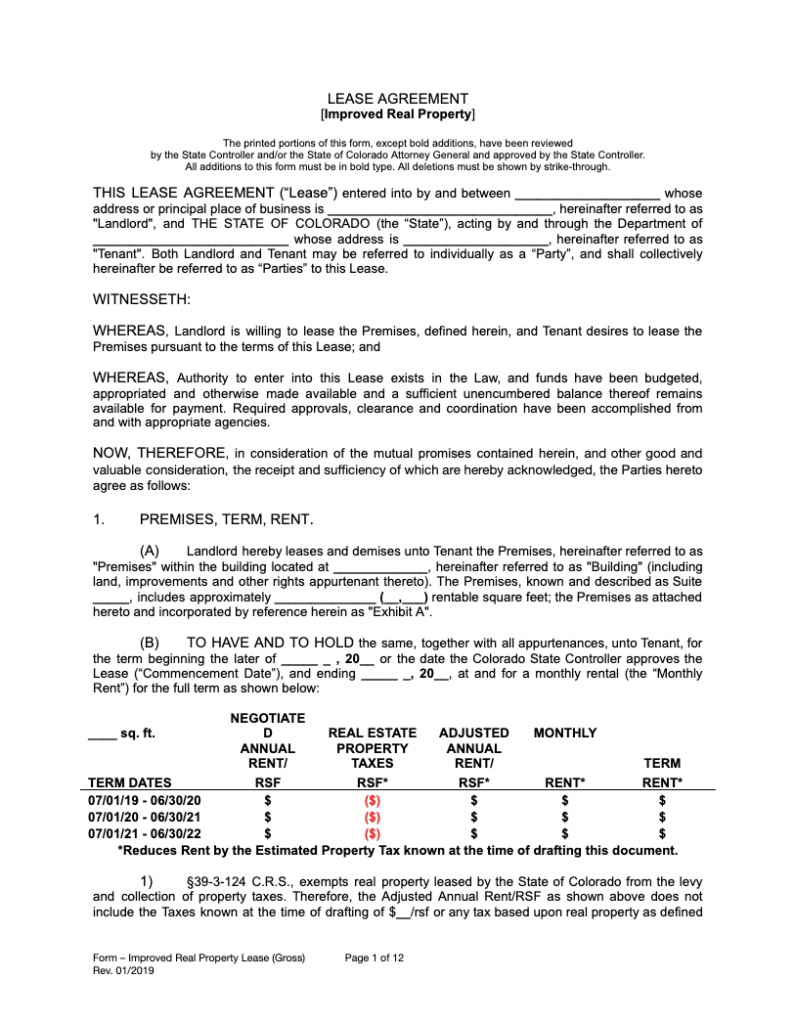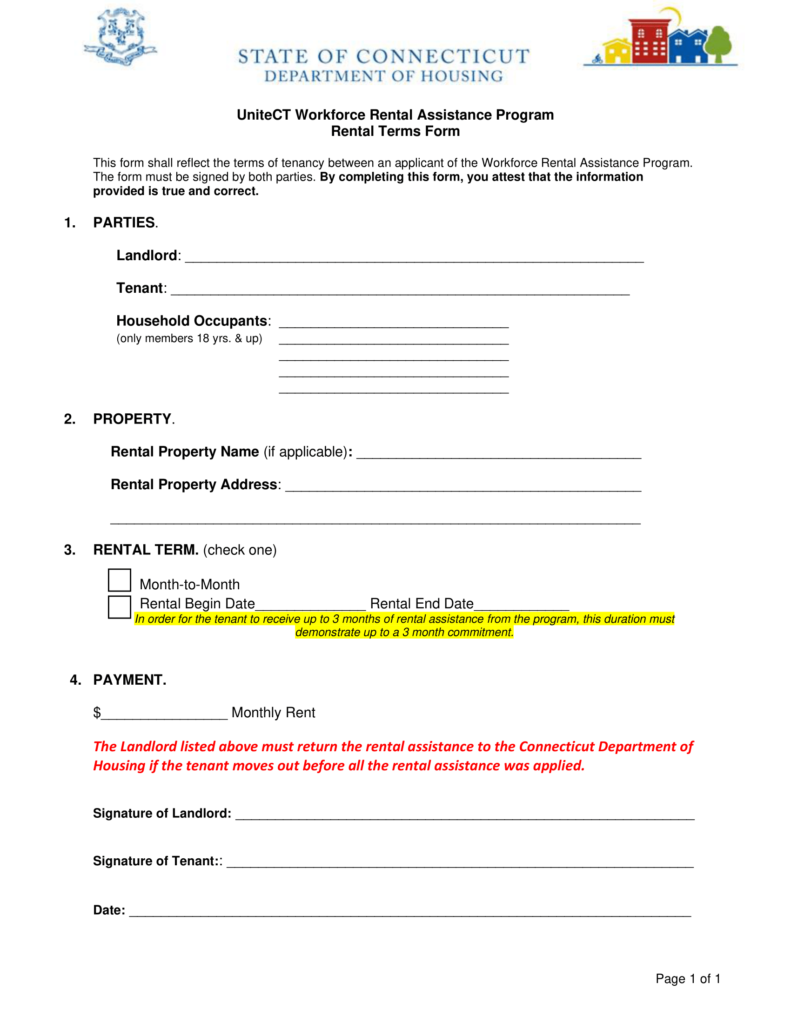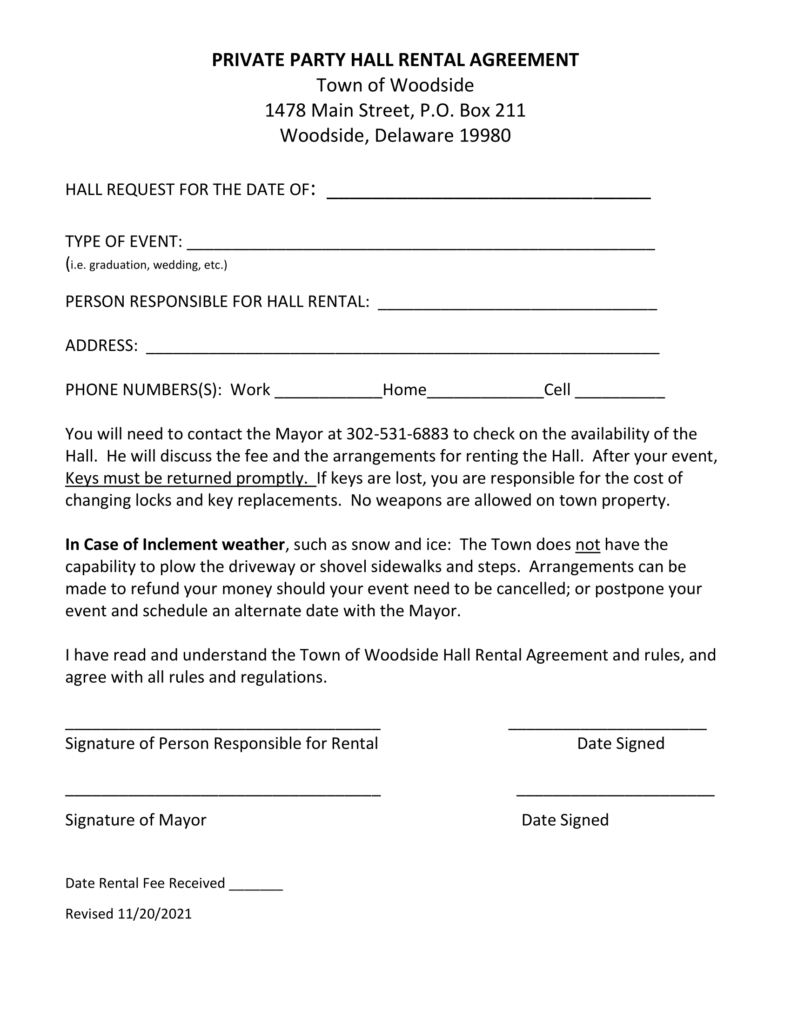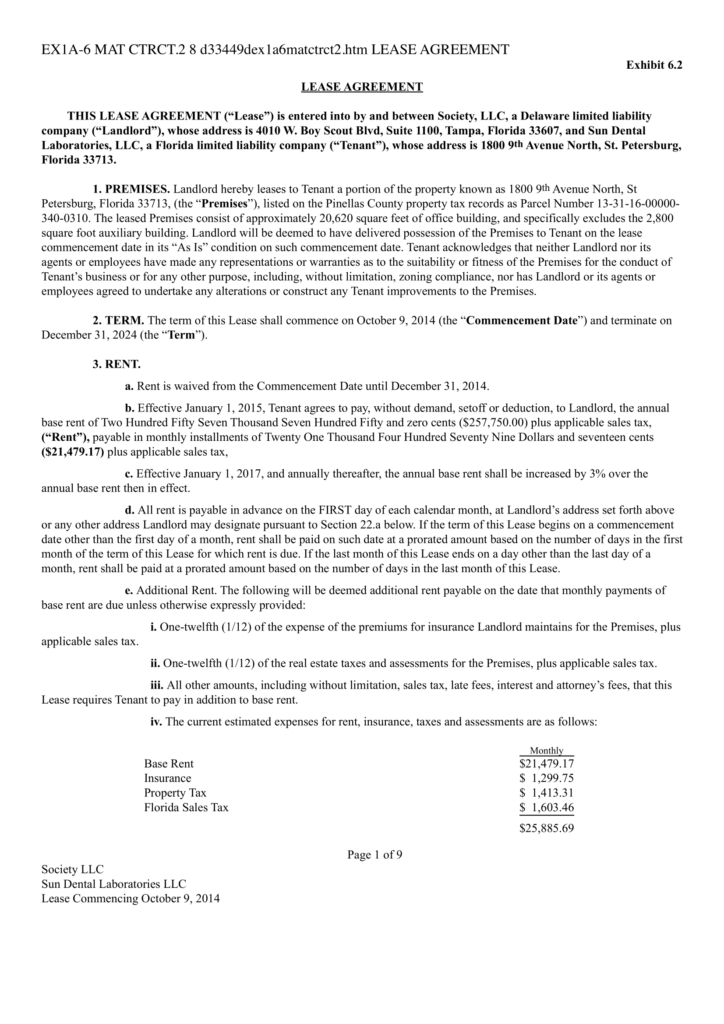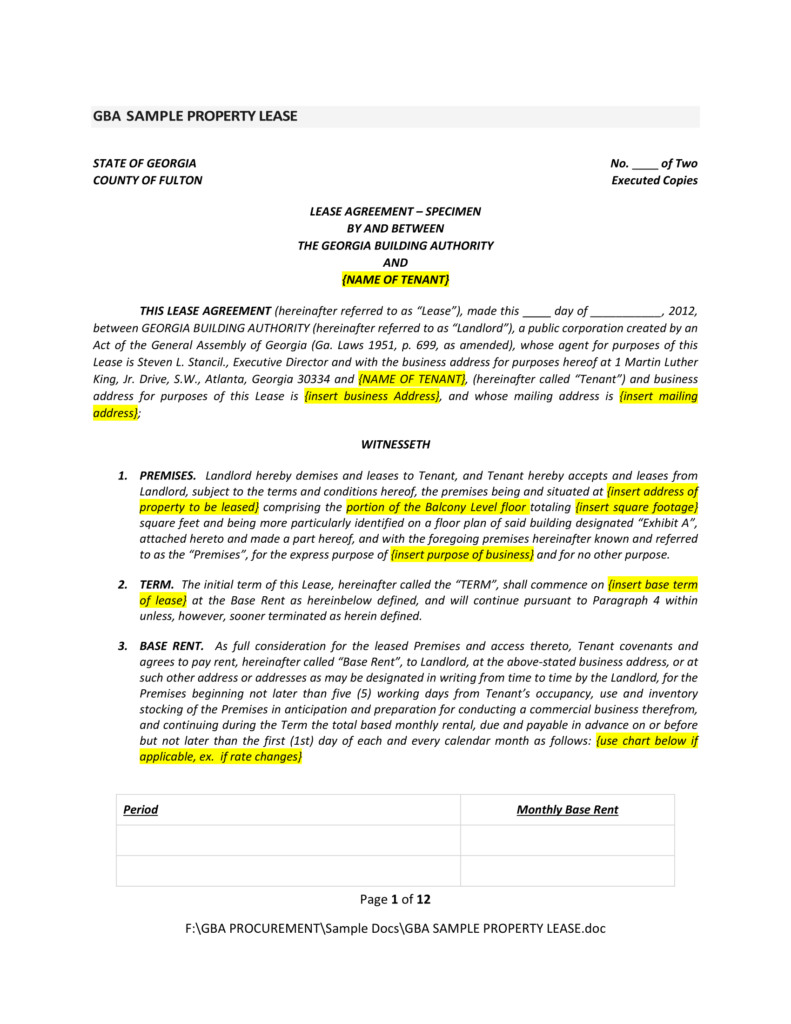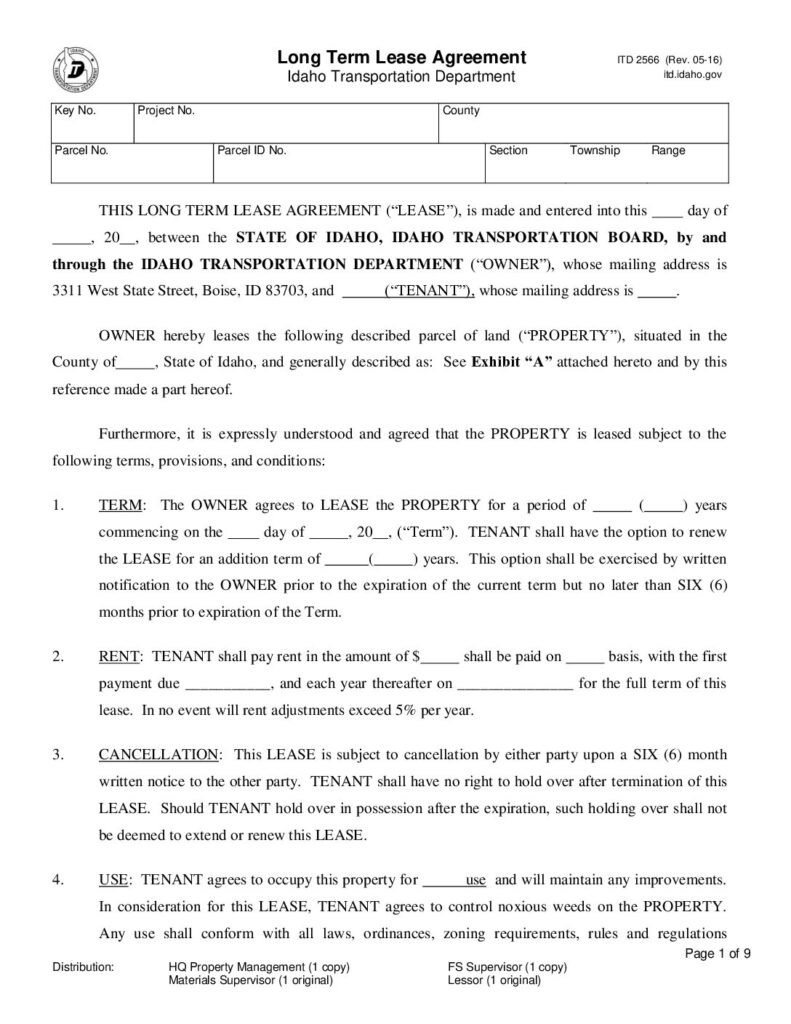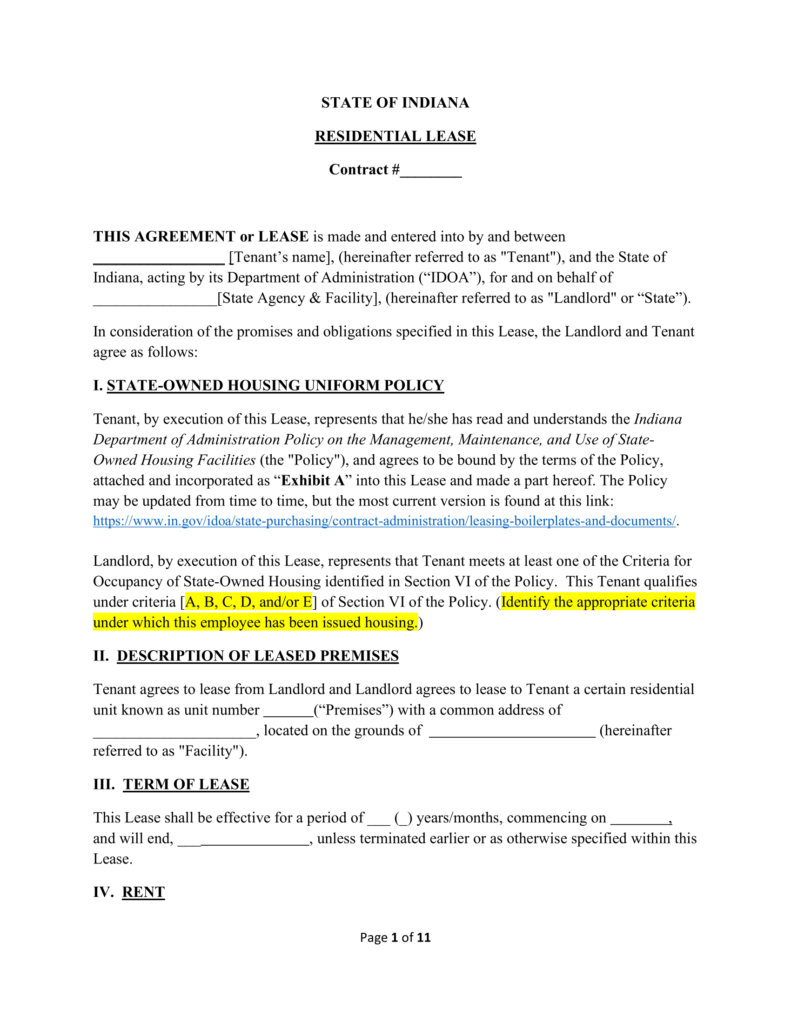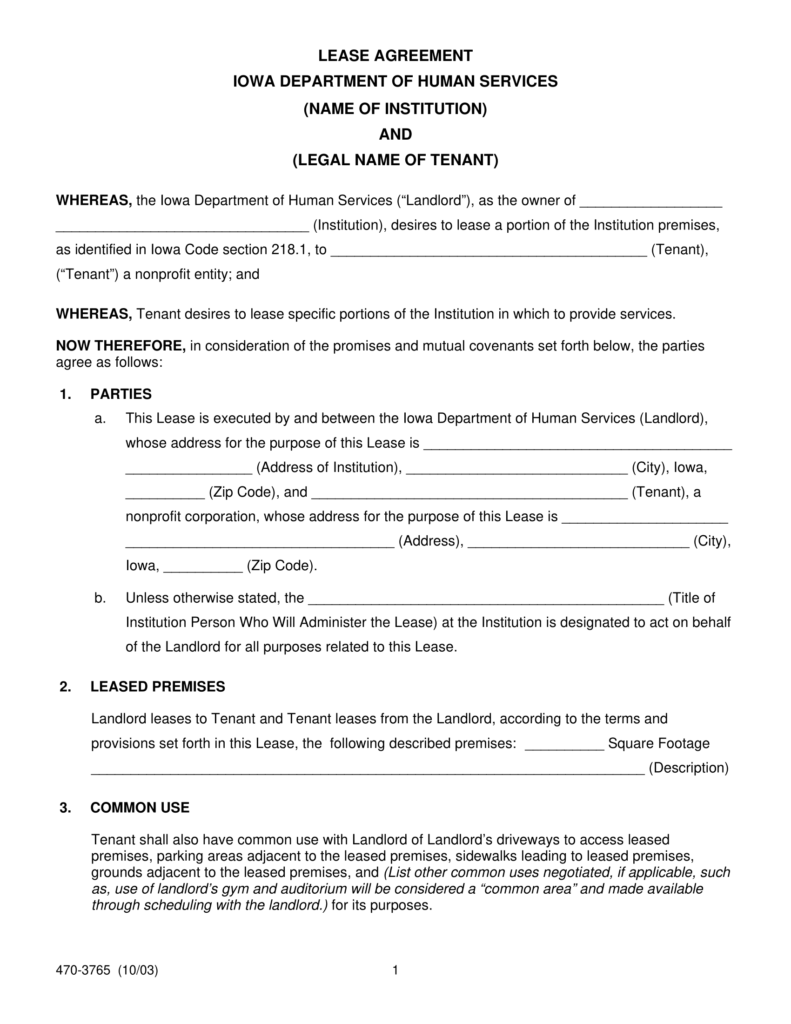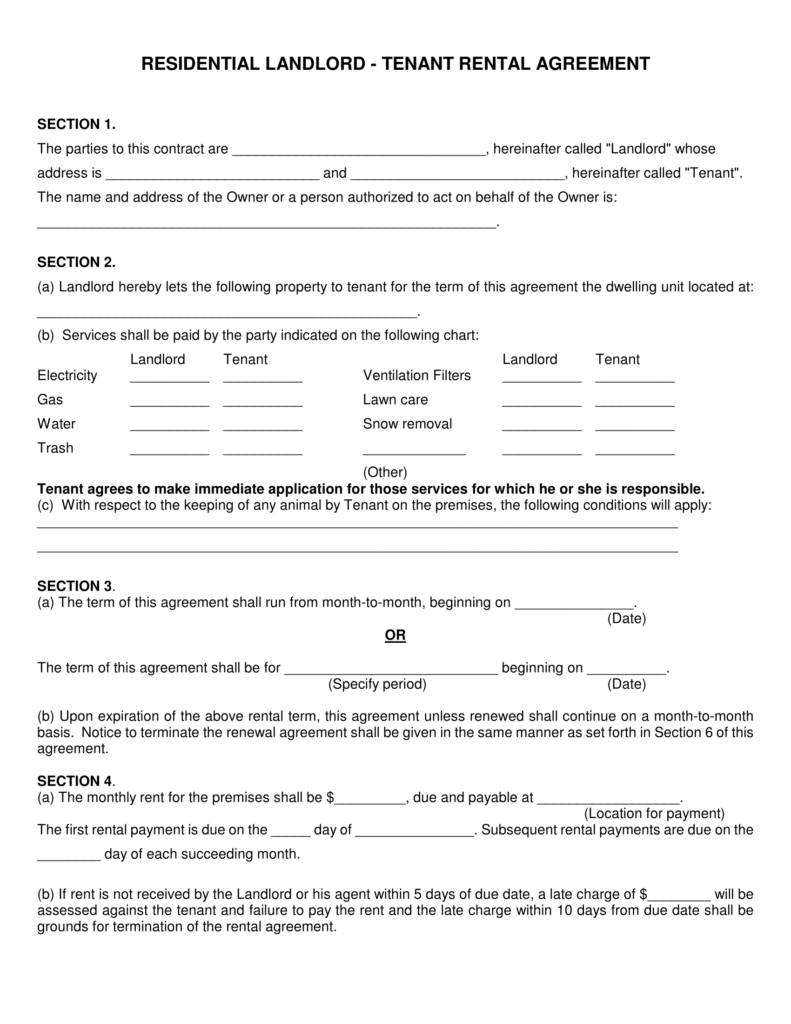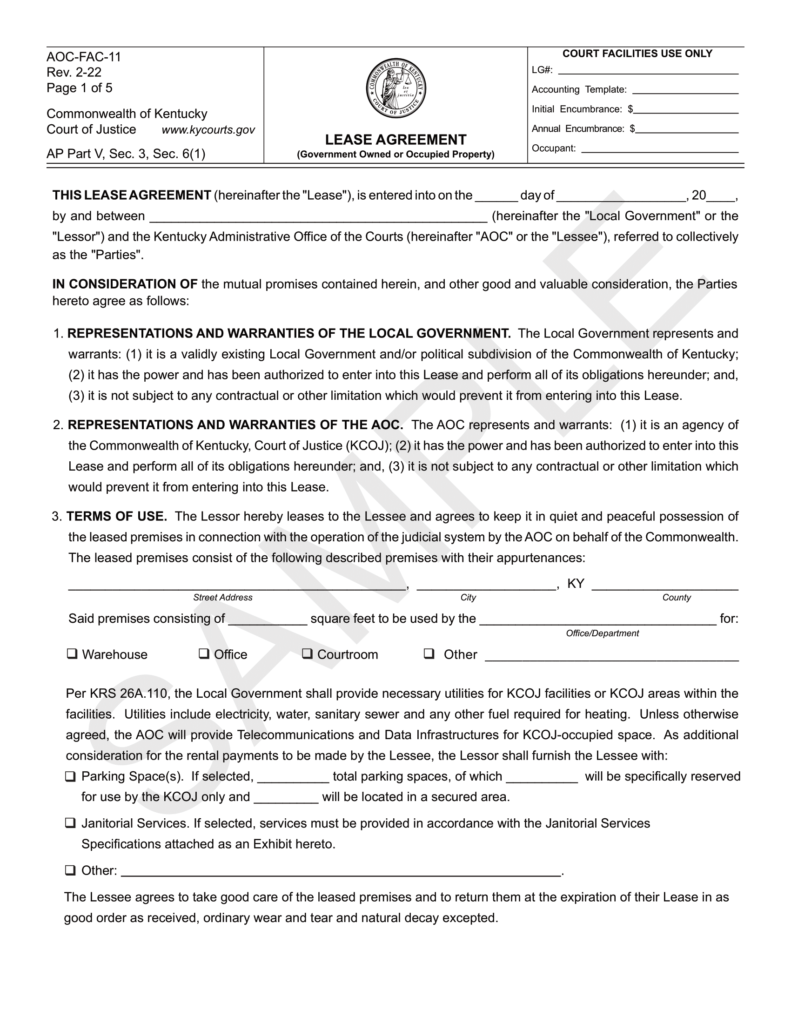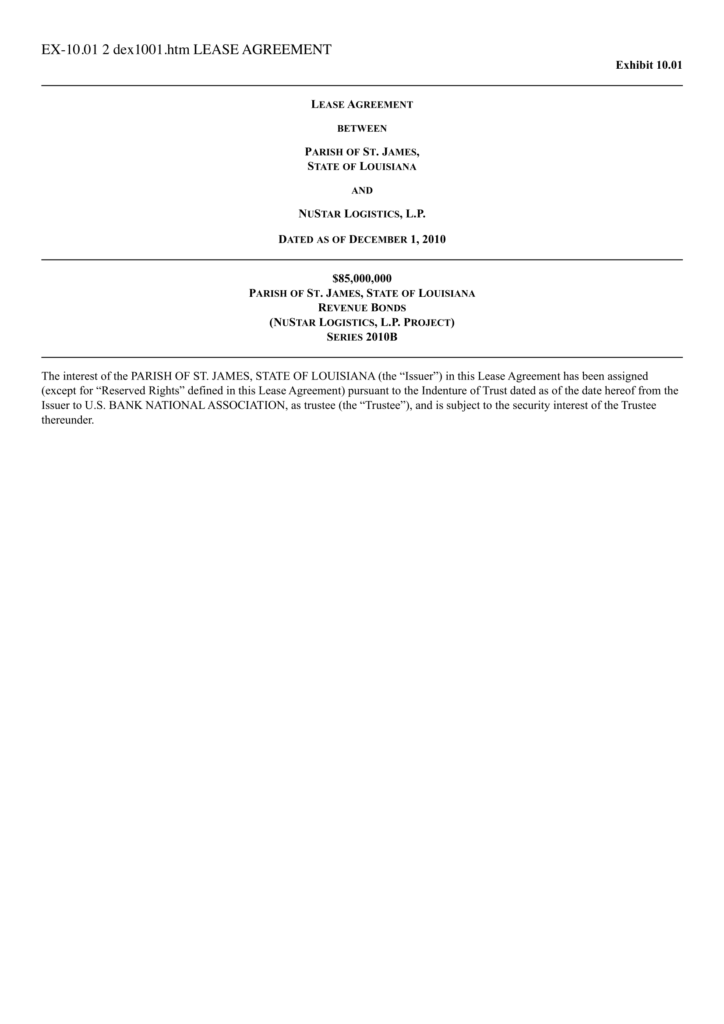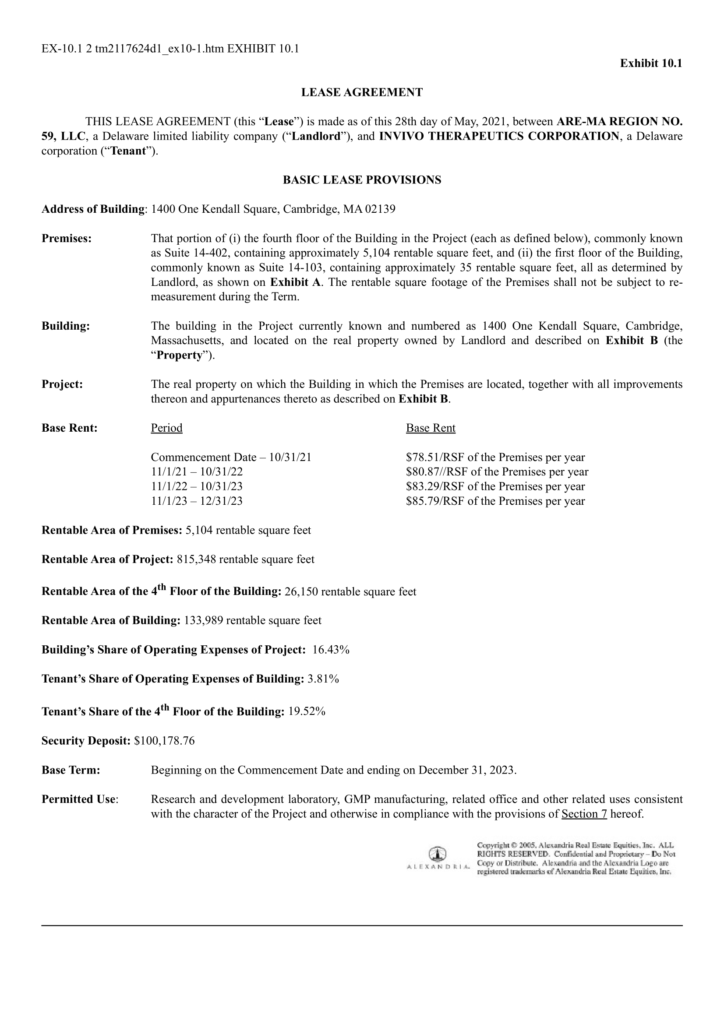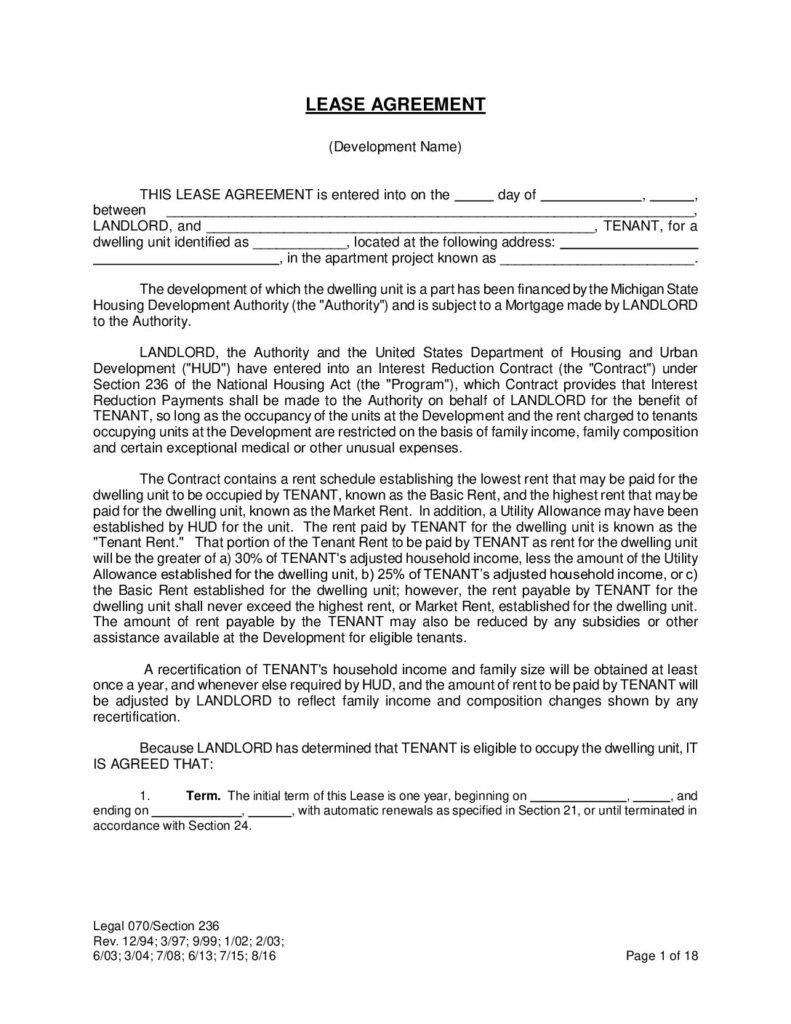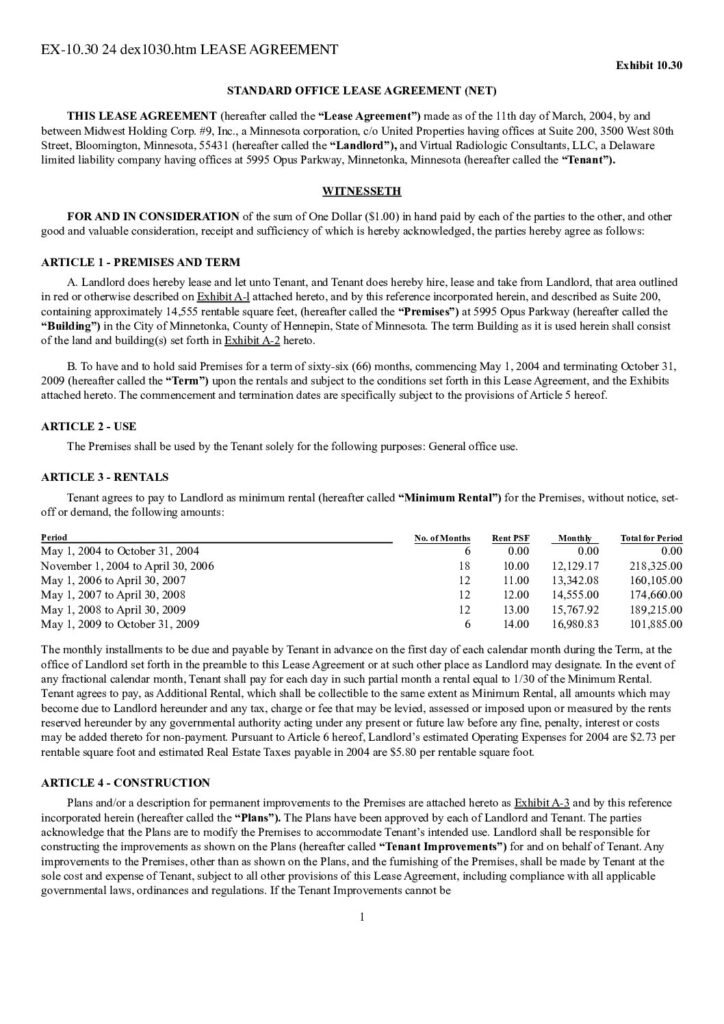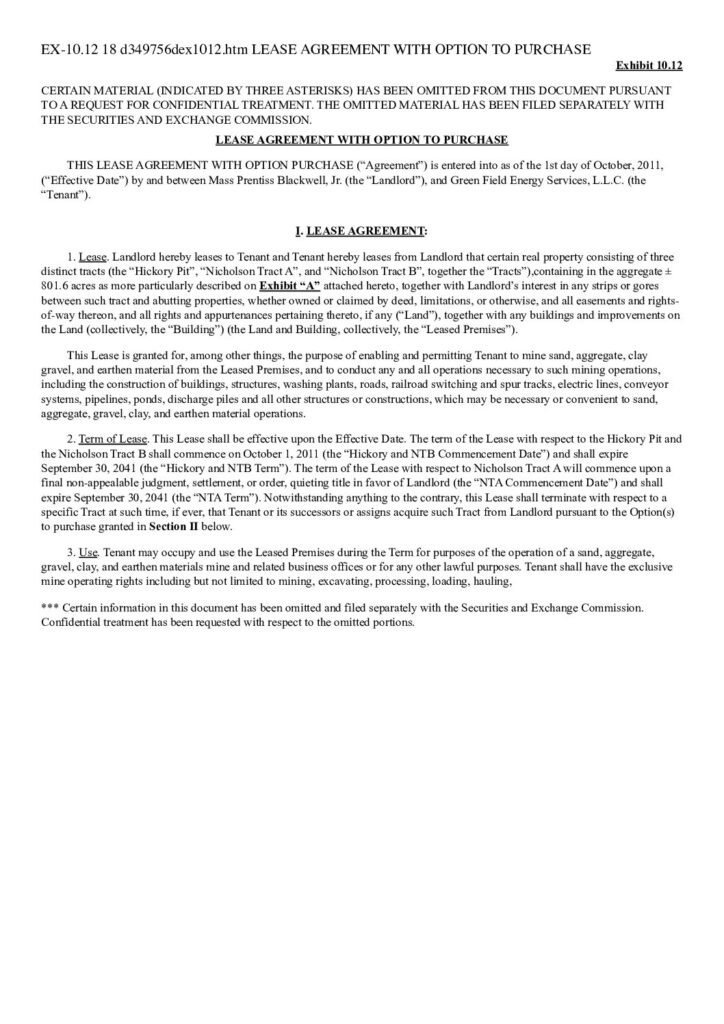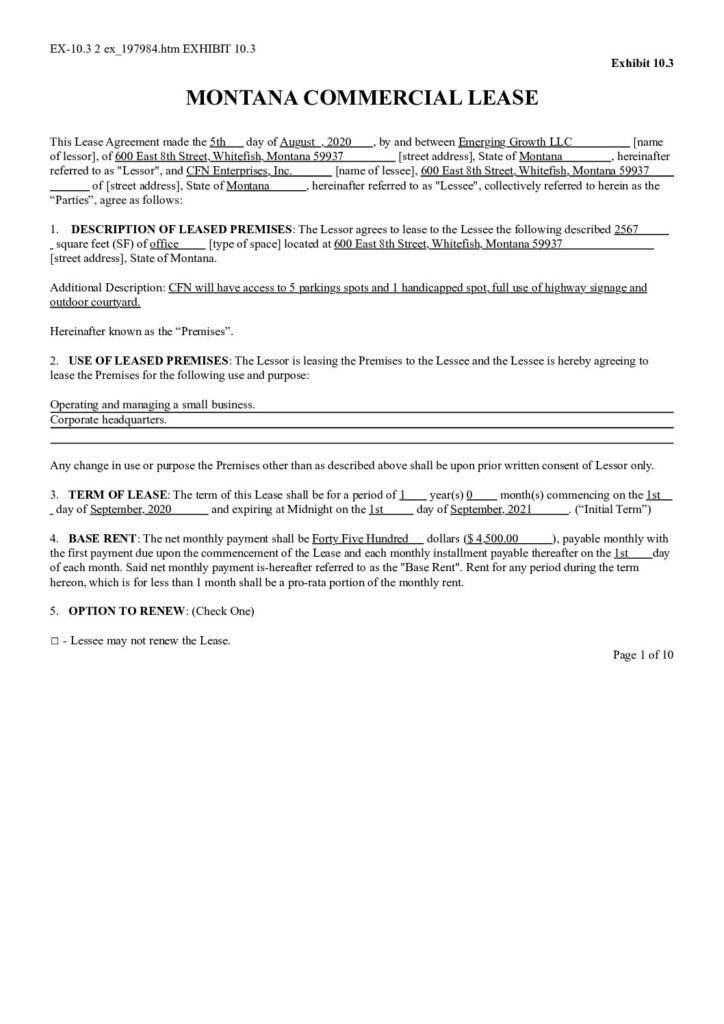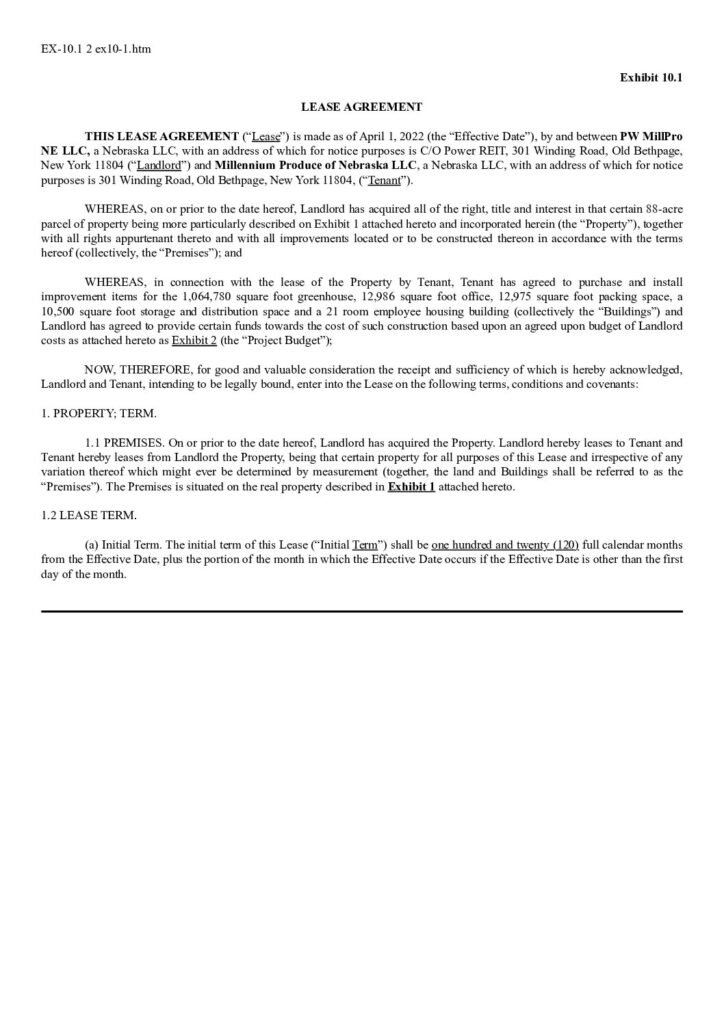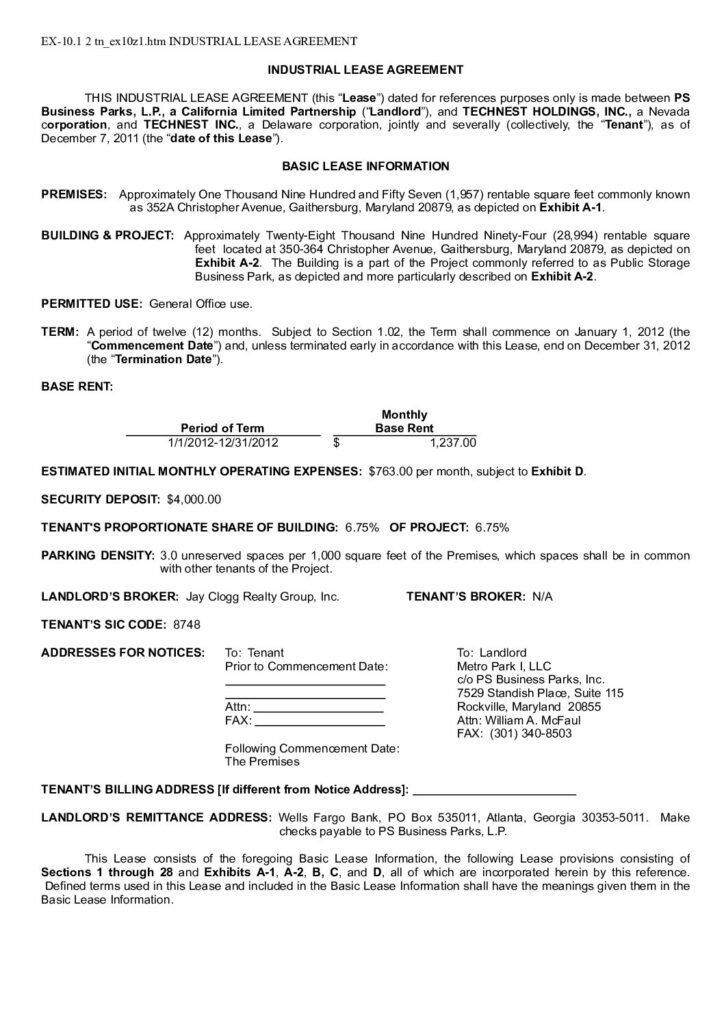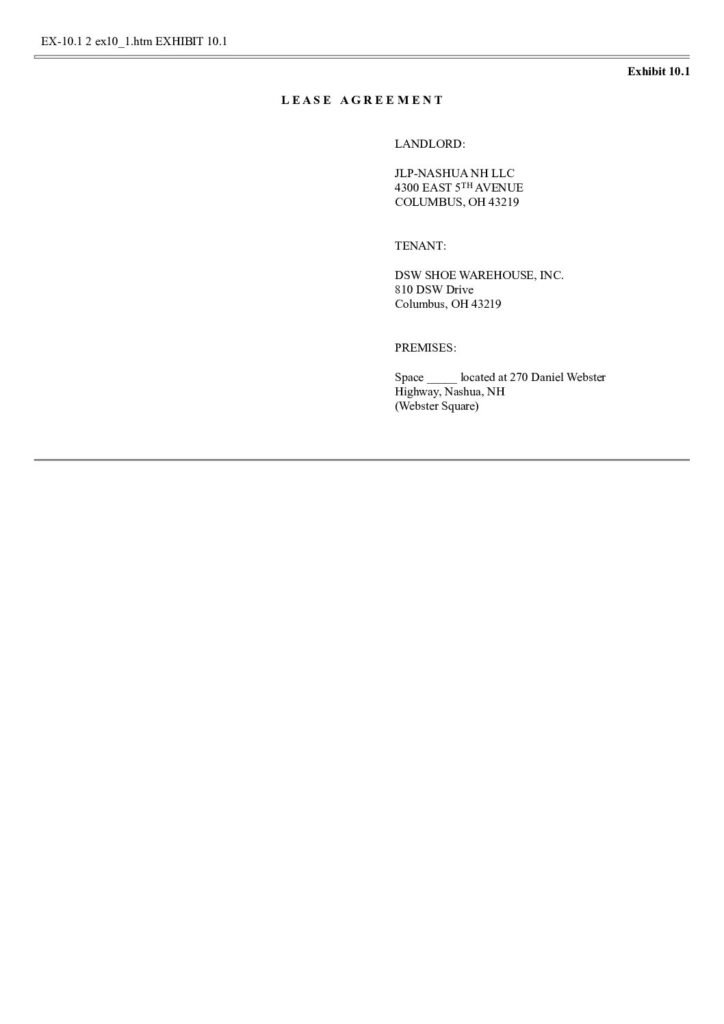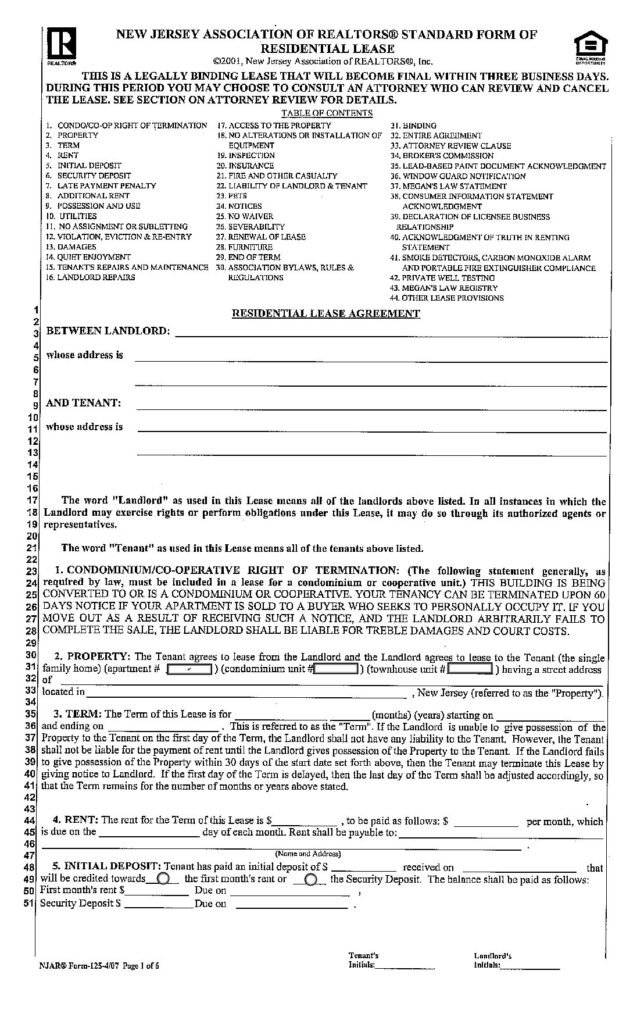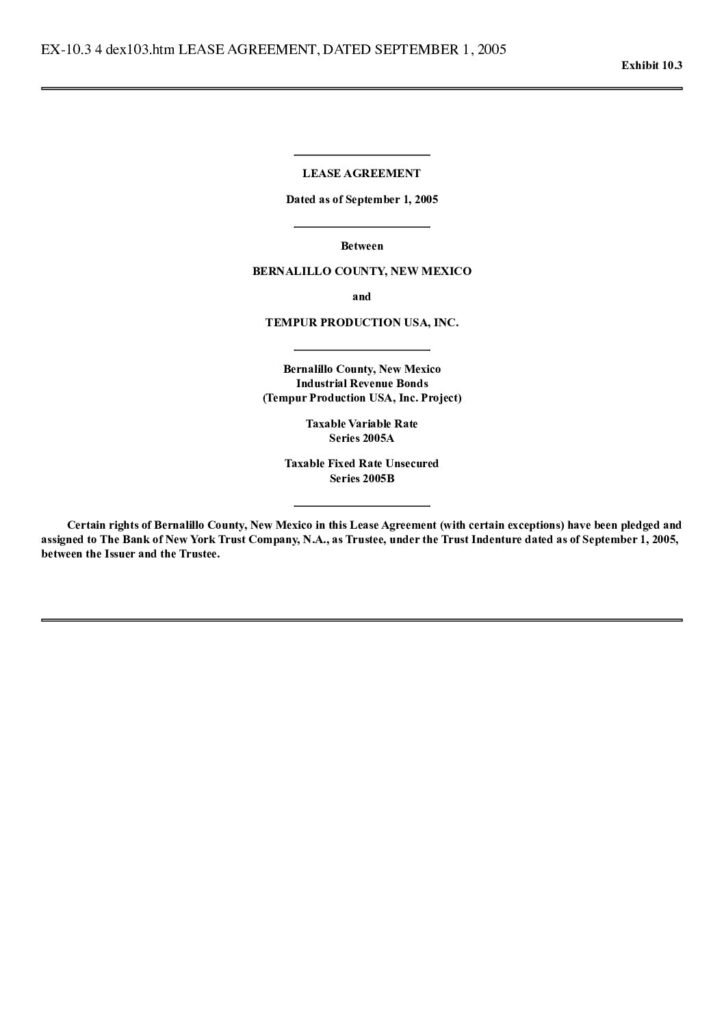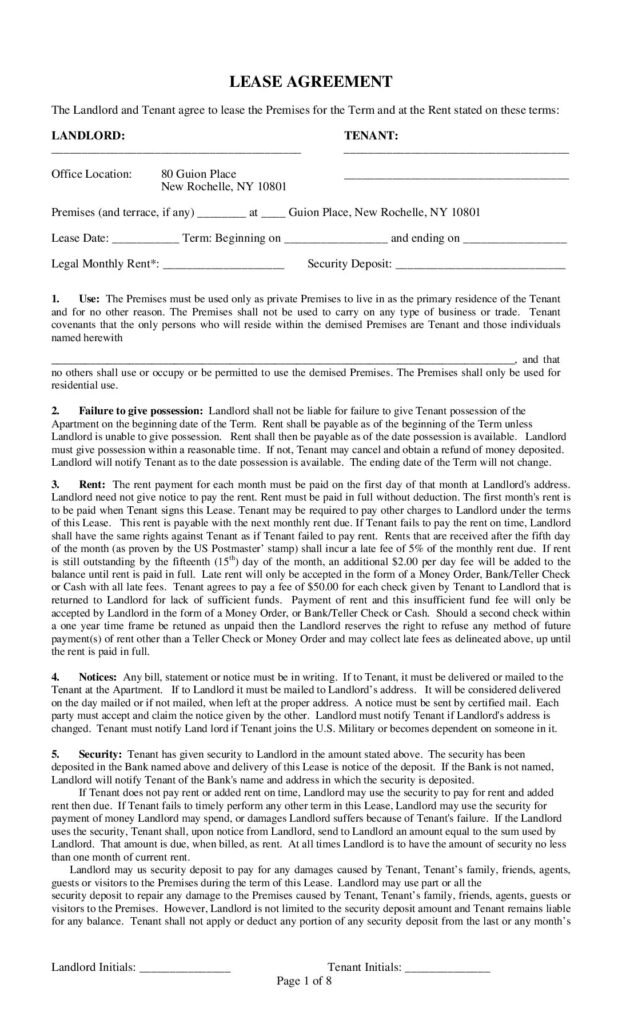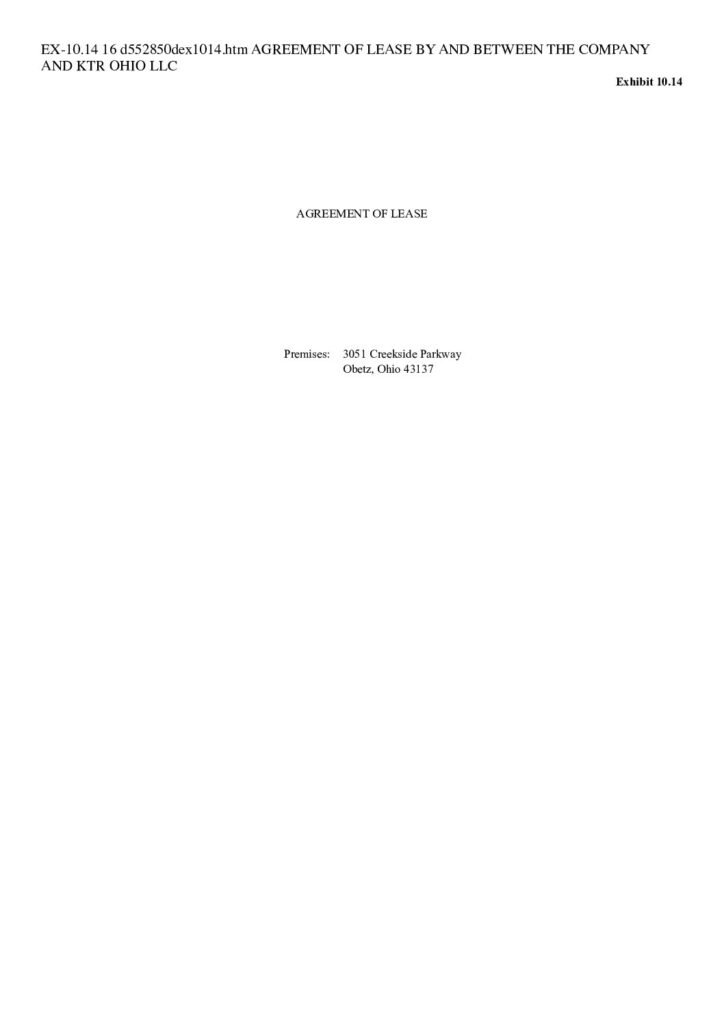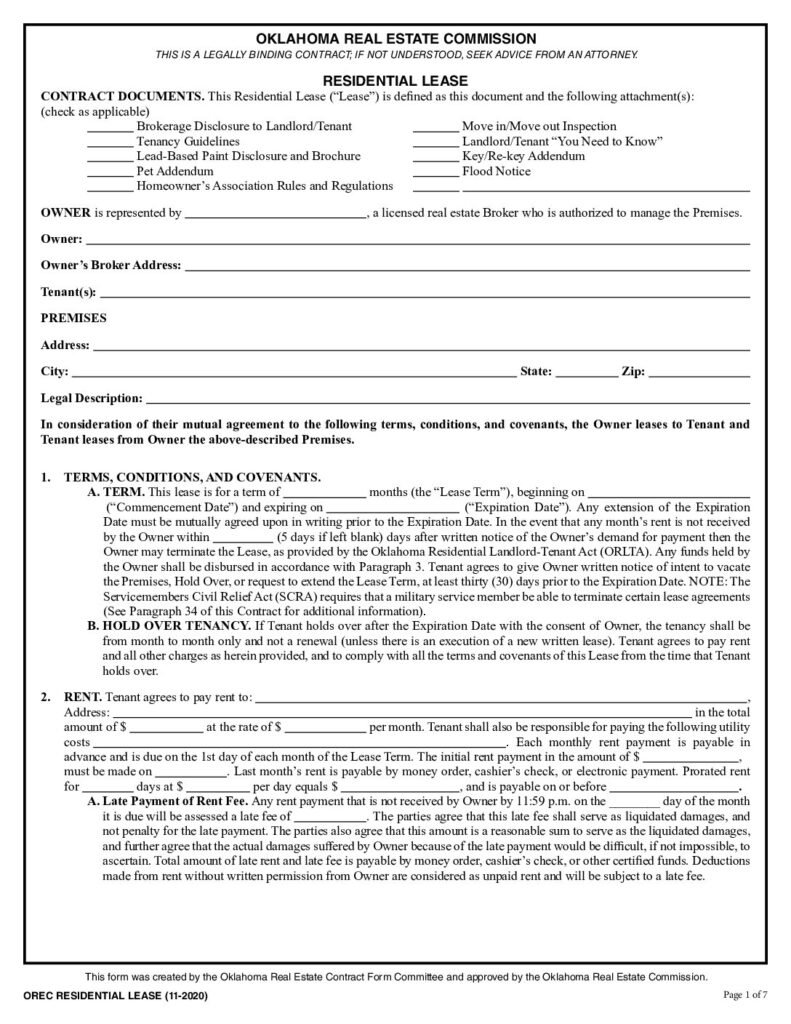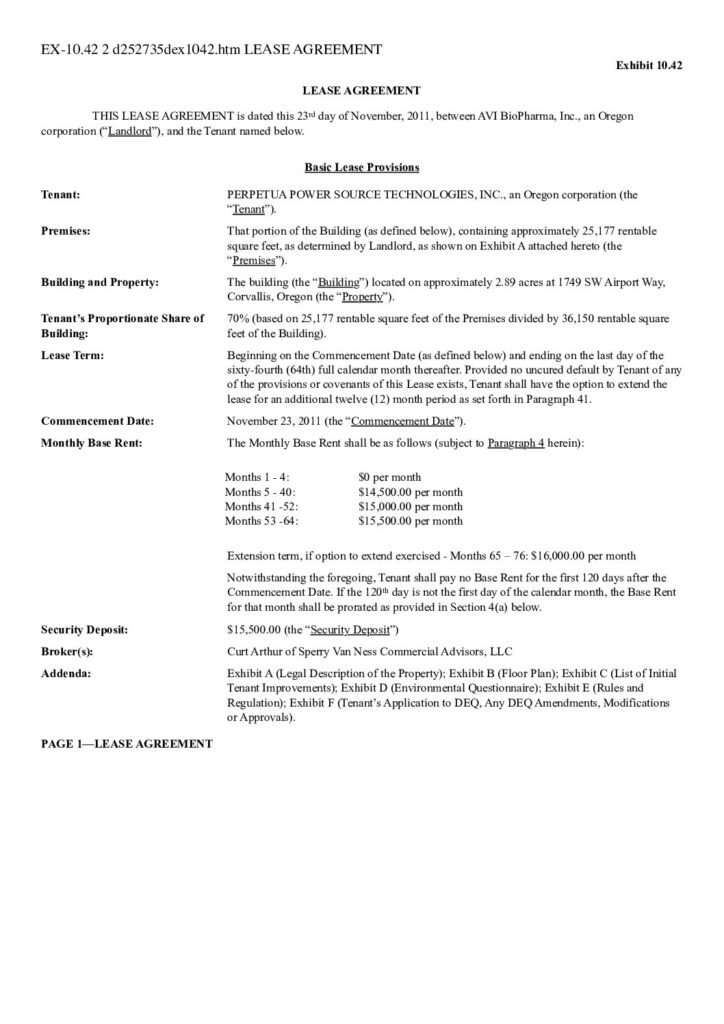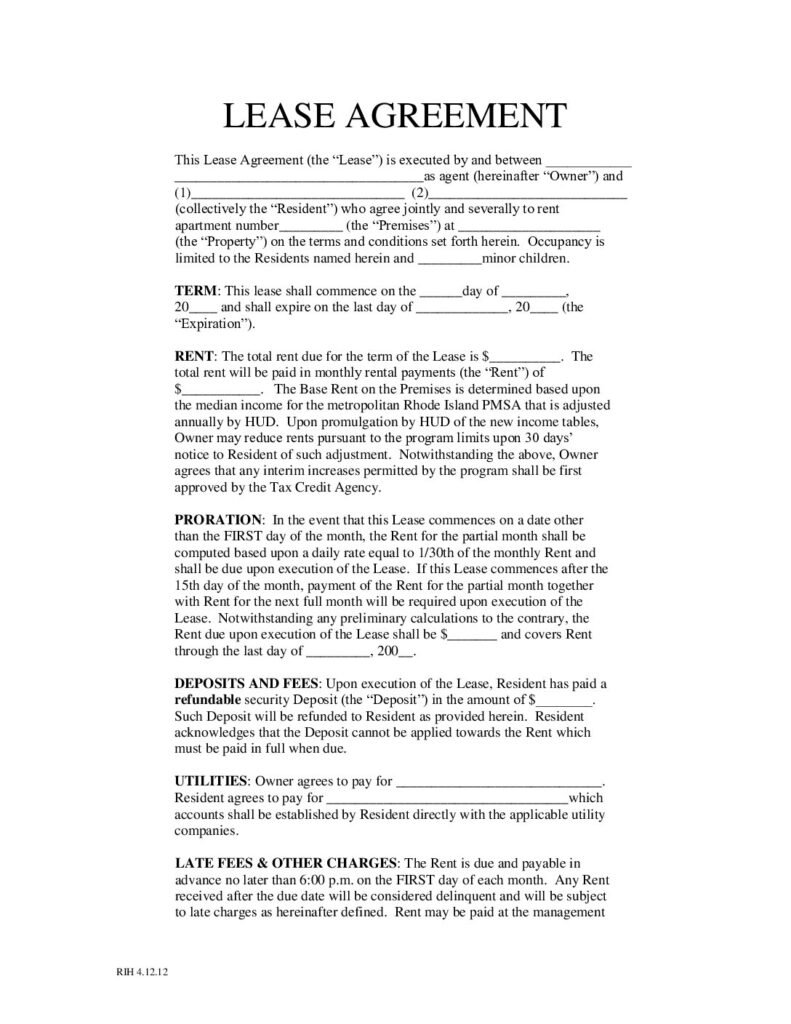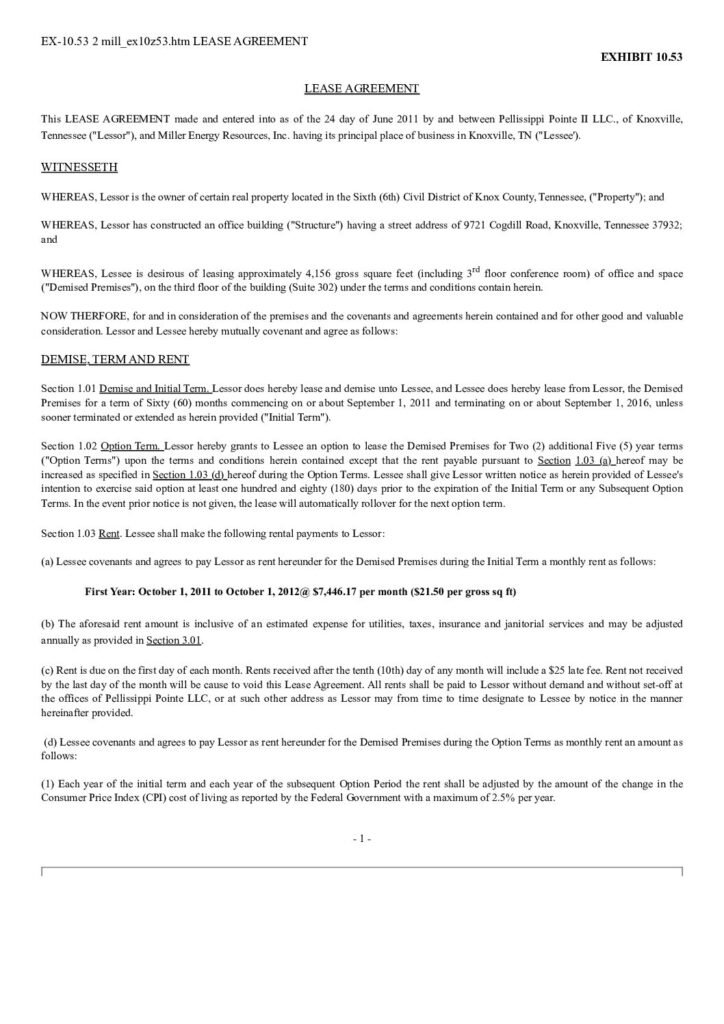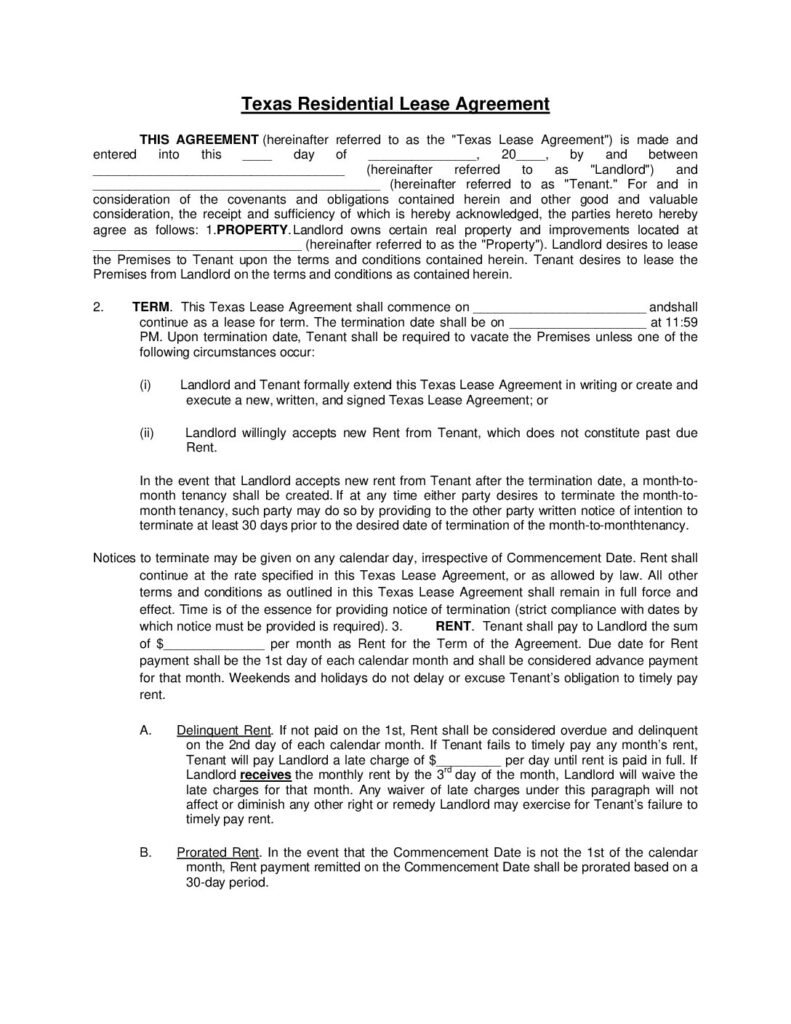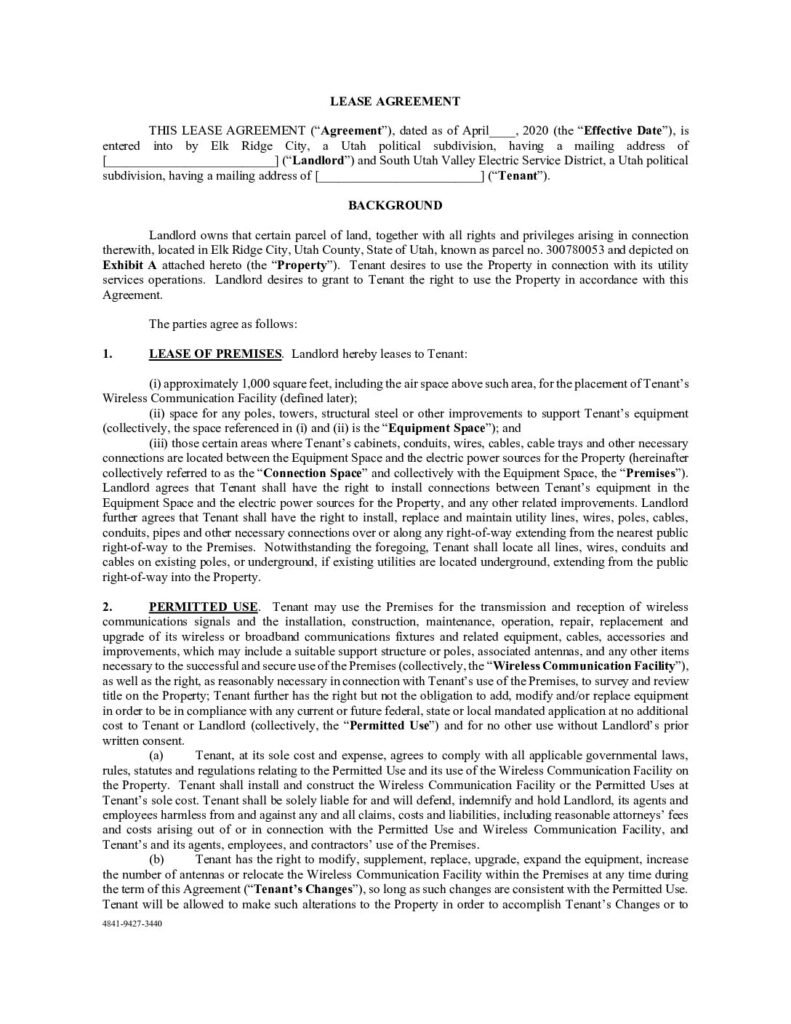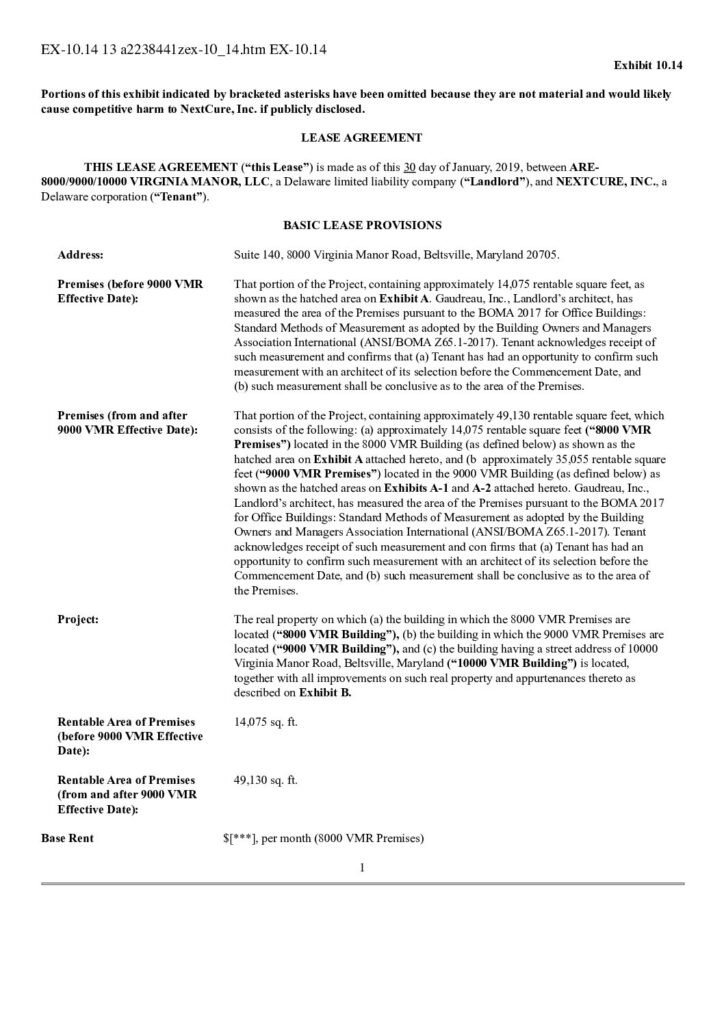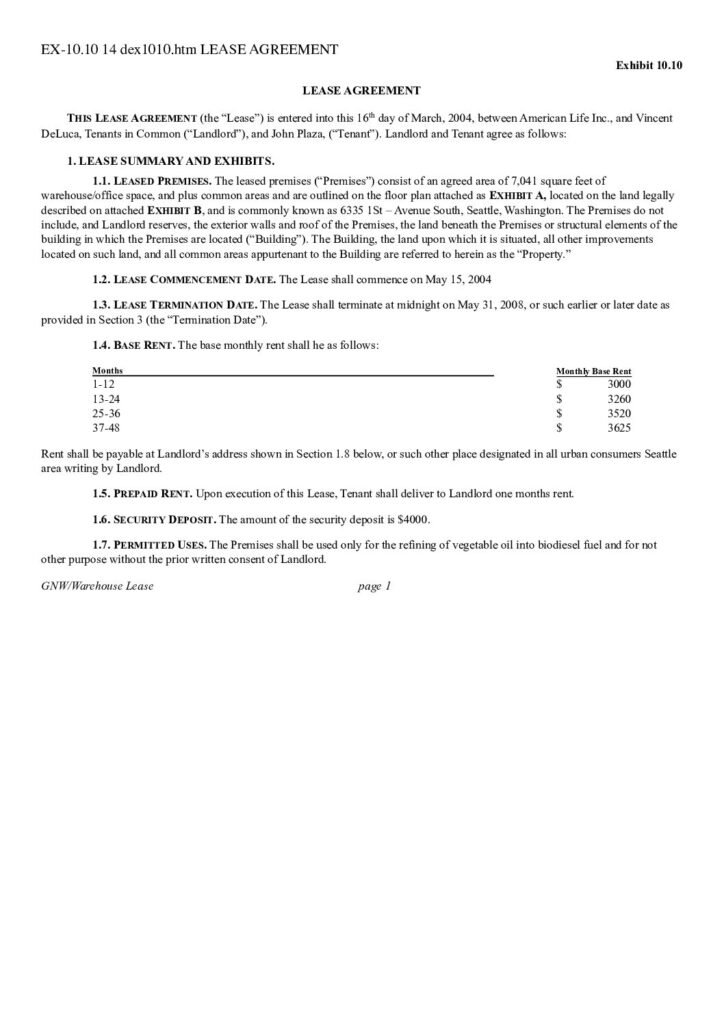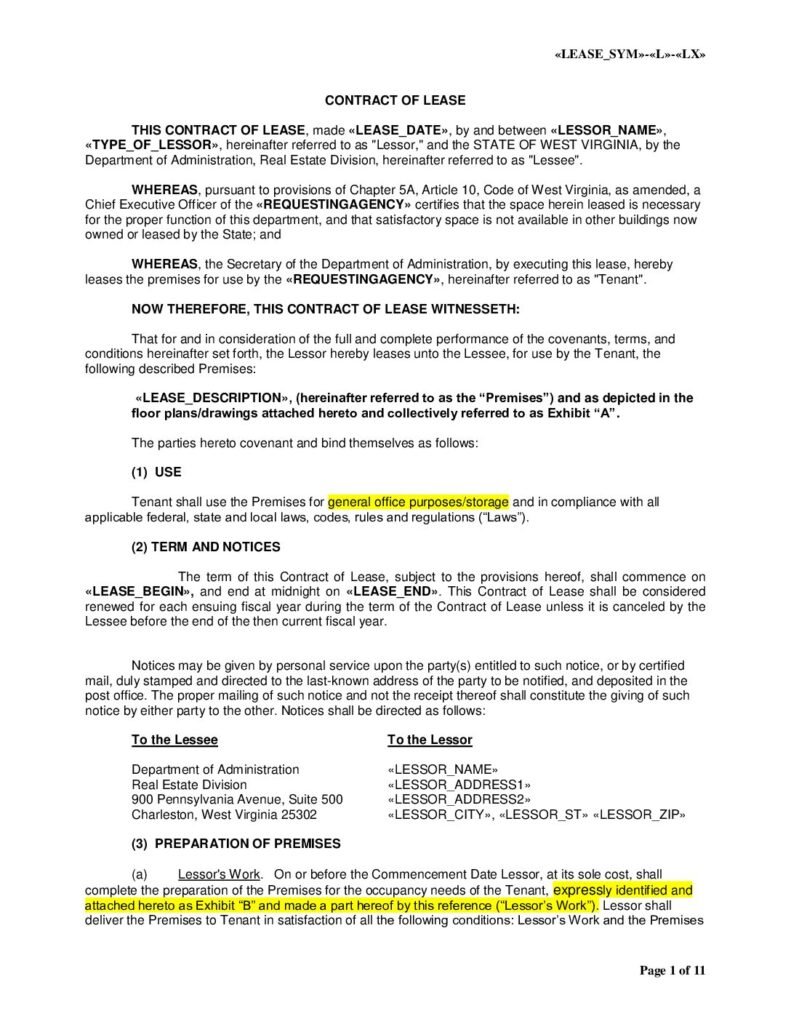Discover our comprehensive Rental/Lease Agreement Guide! This resource encompasses all aspects of rental agreements, offering templates for every situation and US state in convenient Word, PDF, and Google Docs formats. Whether you’re a landlord, tenant, or manager, we’ve got you covered with easy-to-use resources tailored to your needs. Navigate the complexities of rental agreements with confidence, knowing you have access to a wealth of information at your fingertips. Simplify the process of drafting, signing, renewing, or canceling agreements with our user-friendly templates designed to streamline your rental experience.
Rental Lease Agreement Templates, Samples & Examples
- Alabama
- Alaska
- Arizona
- Arkansas
- Californi
- Colorado
- Connecticut
- Delaware
- Florida
- Georgia
- Hawaii
- Idaho
- Illinois
- Indiana
- Lowa
- Kansas
- Kentucky
- Louisiana
- Maine
- Maryland
- Massachusetts
- Michigan
- Minnesota
- Mississippi
- Missouri
- Montana
- Nebraska
- Nevada
- New Hampshire
- New Jersey
- New Mexico
- New York
- North Carolina
- North Dakota
- Ohio
- Oklahoma
- Oregon
- Pennsylvania
- Rhode Island
- South Carolina
- South Dakota
- Tennessee
- Texas
- Utah
- Vermont
- Virginia
- Washington
- West Virginia
- Wisconsin
- Wyoming
Lease/ Rental Agreement Format
RENTAL AGREEMENT
This Rental Agreement (the "Agreement") is entered into on [Date], by and between [Landlord's Name], hereinafter referred to as "Landlord", and [Tenant's Name], hereinafter referred to as "Tenant".
1. Premises
Landlord hereby leases to Tenant and Tenant hereby rents from Landlord the premises located at [Address], including all improvements and fixtures thereon (the "Premises").
2. Term
The term of this Agreement shall commence on [Start Date] and shall continue until [End Date], unless terminated earlier in accordance with the terms herein.
3. Rent
Tenant shall pay rent to Landlord in the amount of [Rent Amount] per [Rent Payment Period], payable in advance on the [Rent Due Date] of each month. Rent shall be payable by [Payment Method].
4. Security Deposit
Tenant shall deposit with Landlord the sum of [Security Deposit Amount] as security for the faithful performance of Tenant's obligations hereunder. The security deposit shall be refunded to Tenant, less any deductions for damages or unpaid rent, within [Number of Days] days after the termination of this Agreement.
5. Use of Premises
Tenant shall use the Premises solely for residential purposes and shall not use the Premises for any unlawful or improper purpose.
6. Maintenance and Repairs
Tenant shall maintain the Premises in a clean and sanitary condition and shall promptly notify Landlord of any repairs or maintenance required.
7. Utilities
Tenant shall be responsible for all utilities and services provided to the Premises during the term of this Agreement.
8. Entry by Landlord
Landlord or Landlord's agents may enter the Premises at reasonable times and upon reasonable notice to Tenant for the purpose of inspection, repairs, or showing the Premises to prospective tenants or purchasers.
9. Termination
This Agreement may be terminated by either party upon [Notice Period] days' written notice to the other party.
10. Governing Law
This Agreement shall be governed by and construed in accordance with the laws of the State of [State].
IN WITNESS WHEREOF, the parties hereto have executed this Agreement as of the date first above written.
Landlord: [Landlord's Signature]
Tenant: [Tenant's Signature]
One Page Rental Agreement

RENTAL AGREEMENT
This Rental Agreement ("Agreement") is made effective as of [Date], between [Landlord's Name], hereinafter referred to as "Landlord", and [Tenant's Name], hereinafter referred to as "Tenant".
Premises: The Landlord hereby leases to Tenant and Tenant rents from Landlord the premises located at [Address], including all improvements and fixtures thereon.
Term: The term of this Agreement shall commence on [Start Date] and shall continue until [End Date], unless terminated earlier in accordance with the terms herein.
Rent: Tenant shall pay rent to Landlord in the amount of [Rent Amount] per [Rent
Payment Period], payable in advance on the [Rent Due Date] of each month.
Security Deposit: Tenant shall deposit with Landlord the sum of [Security Deposit Amount] as security for the faithful performance of Tenant's obligations hereunder.
Use of Premises: Tenant shall use the Premises solely for residential purposes and shall not use the Premises for any unlawful or improper purpose.
Maintenance and Repairs: Tenant shall maintain the Premises in a clean and sanitary condition and shall promptly notify Landlord of any repairs or maintenance required.
Utilities: Tenant shall be responsible for all utilities and services provided to the Premises during the term of this Agreement.
Entry by Landlord: Landlord or Landlord's agents may enter the Premises at reasonable times and upon reasonable notice to Tenant for the purpose of inspection, repairs, or showing the Premises to prospective tenants or purchasers.
Termination: This Agreement may be terminated by either party upon [Notice Period] days' written notice to the other party.
Governing Law: This Agreement shall be governed by and construed in accordance with the laws of the State of [State].
IN WITNESS WHEREOF, the parties hereto have executed this Agreement as of the date first above written.
Landlord: [Landlord's Signature] Tenant: [Tenant's Signature]
Short Term Rental Agreement
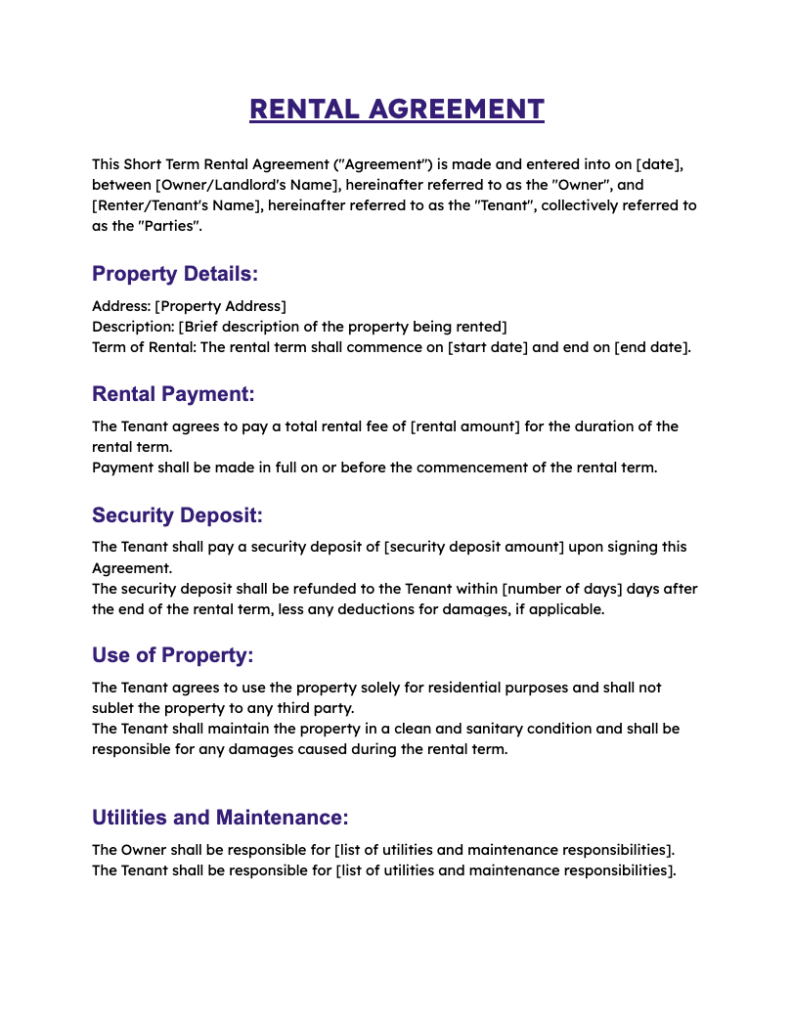
RENTAL AGREEMENT
This Short Term Rental Agreement ("Agreement") is made and entered into on [date], between [Owner/Landlord's Name], hereinafter referred to as the "Owner", and [Renter/Tenant's Name], hereinafter referred to as the "Tenant", collectively referred to as the "Parties".
Property Details:
Address: [Property Address]
Description: [Brief description of the property being rented]
Term of Rental: The rental term shall commence on [start date] and end on [end date].
Rental Payment:
The Tenant agrees to pay a total rental fee of [rental amount] for the duration of the rental term.
Payment shall be made in full on or before the commencement of the rental term.
Security Deposit:
The Tenant shall pay a security deposit of [security deposit amount] upon signing this Agreement.
The security deposit shall be refunded to the Tenant within [number of days] days after the end of the rental term, less any deductions for damages, if applicable.
Use of Property:
The Tenant agrees to use the property solely for residential purposes and shall not sublet the property to any third party.
The Tenant shall maintain the property in a clean and sanitary condition and shall be responsible for any damages caused during the rental term.
Utilities and Maintenance:
The Owner shall be responsible for [list of utilities and maintenance responsibilities].
The Tenant shall be responsible for [list of utilities and maintenance responsibilities].
Termination:
Either party may terminate this Agreement by providing written notice to the other party at least [number of days] days prior to the intended date of termination.
Governing Law:
This Agreement shall be governed by and construed in accordance with the laws of [state/country].
Signatures:
The Parties hereby acknowledge that they have read and understood the terms and conditions of this Agreement and agree to be bound by them.
Owner's Signature: __________________________
Tenant's Signature: __________________________
Date: __________________________
Simple Lease Agreement
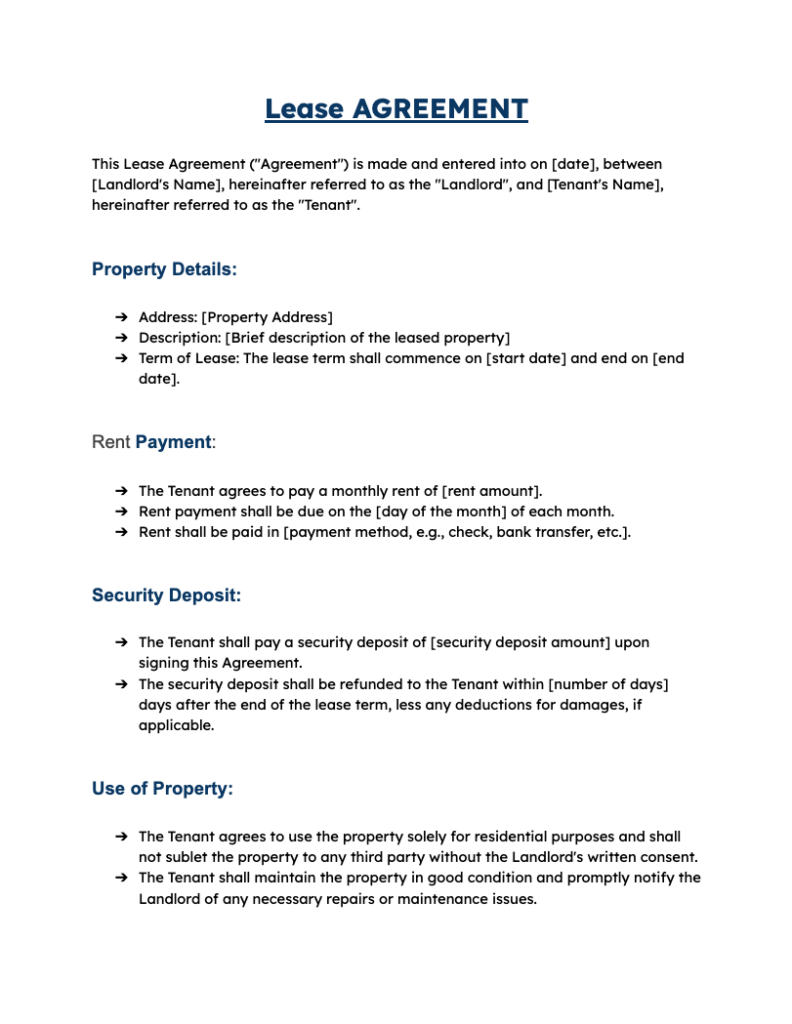
Lease AGREEMENT
This Lease Agreement ("Agreement") is made and entered into on [date], between [Landlord's Name], hereinafter referred to as the "Landlord", and [Tenant's Name], hereinafter referred to as the "Tenant".
Property Details:
Address: [Property Address]
Description: [Brief description of the leased property]
Term of Lease: The lease term shall commence on [start date] and end on [end date].
Rent Payment:
The Tenant agrees to pay a monthly rent of [rent amount].
Rent payment shall be due on the [day of the month] of each month.
Rent shall be paid in [payment method, e.g., check, bank transfer, etc.].
Security Deposit:
The Tenant shall pay a security deposit of [security deposit amount] upon signing this Agreement.
The security deposit shall be refunded to the Tenant within [number of days] days after the end of the lease term, less any deductions for damages, if applicable.
Use of Property:
The Tenant agrees to use the property solely for residential purposes and shall not sublet the property to any third party without the Landlord's written consent.
The Tenant shall maintain the property in good condition and promptly notify the Landlord of any necessary repairs or maintenance issues.
Utilities:
The Landlord shall be responsible for [list of utilities and services provided by the Landlord].
The Tenant shall be responsible for [list of utilities and services to be paid by the Tenant, if any].
Termination:
Either party may terminate this Agreement by providing written notice to the other party at least [number of days] days prior to the intended date of termination.
Governing Law:
This Agreement shall be governed by and construed in accordance with the laws of [state/country].
Signatures:
The Parties hereby acknowledge that they have read and understood the terms and conditions of this Agreement and agree to be bound by them.
Landlord's Signature: __________________________
Tenant's Signature: __________________________
Date: __________________________
House Rental Agreement
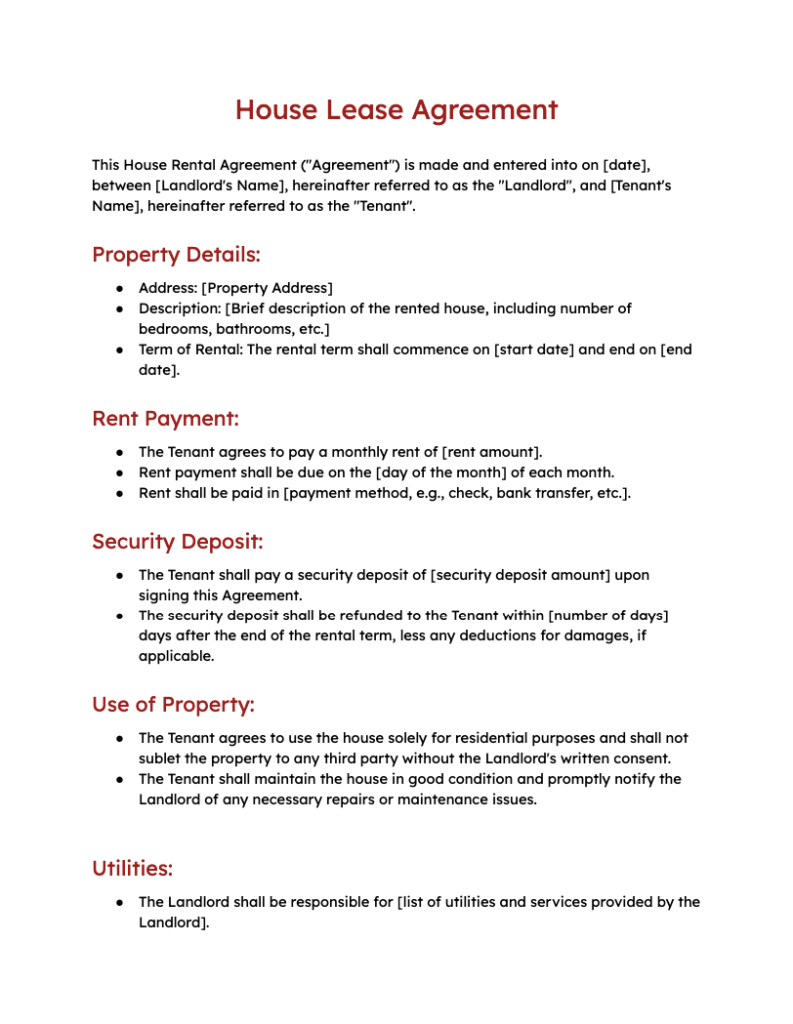
House Lease Agreement
This House Rental Agreement ("Agreement") is made and entered into on [date], between [Landlord's Name], hereinafter referred to as the "Landlord", and [Tenant's Name], hereinafter referred to as the "Tenant".
Property Details:
- Address: [Property Address]
- Description: [Brief description of the rented house, including number of bedrooms, bathrooms, etc.]
- Term of Rental: The rental term shall commence on [start date] and end on [end date].
Rent Payment:
- The Tenant agrees to pay a monthly rent of [rent amount].
- Rent payment shall be due on the [day of the month] of each month.
- Rent shall be paid in [payment method, e.g., check, bank transfer, etc.].
Security Deposit:
- The Tenant shall pay a security deposit of [security deposit amount] upon signing this Agreement.
- The security deposit shall be refunded to the Tenant within [number of days] days after the end of the rental term, less any deductions for damages, if applicable.
Use of Property:
- The Tenant agrees to use the house solely for residential purposes and shall not sublet the property to any third party without the Landlord's written consent.
- The Tenant shall maintain the house in good condition and promptly notify the Landlord of any necessary repairs or maintenance issues.
Utilities:
- The Landlord shall be responsible for [list of utilities and services provided by the Landlord].
- The Tenant shall be responsible for [list of utilities and services to be paid by the Tenant, if any].
Termination:
Either party may terminate this Agreement by providing written notice to the other party at least [number of days] days prior to the intended date of termination.
Governing Law:
This Agreement shall be governed by and construed in accordance with the laws of [state/country].
Signatures:
The Parties hereby acknowledge that they have read and understood the terms and conditions of this Agreement and agree to be bound by them.
Landlord's Signature: __________________________
Tenant's Signature: __________________________
Date: __________________________
Room Rental Agreement
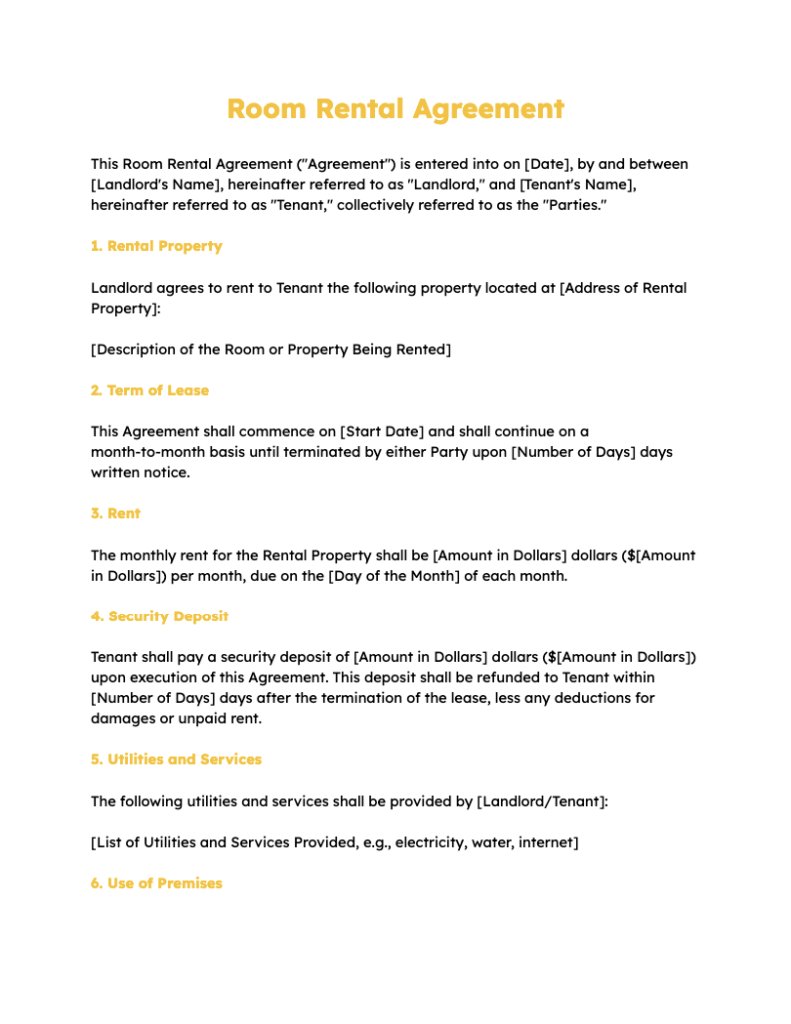
Room Rental Agreement
This Room Rental Agreement ("Agreement") is entered into on [Date], by and between [Landlord's Name], hereinafter referred to as "Landlord," and [Tenant's Name], hereinafter referred to as "Tenant," collectively referred to as the "Parties."
1. Rental Property
Landlord agrees to rent to Tenant the following property located at [Address of Rental Property]:
[Description of the Room or Property Being Rented]
2. Term of Lease
This Agreement shall commence on [Start Date] and shall continue on a month-to-month basis until terminated by either Party upon [Number of Days] days written notice.
3. Rent
The monthly rent for the Rental Property shall be [Amount in Dollars] dollars ($[Amount in Dollars]) per month, due on the [Day of the Month] of each month.
4. Security Deposit
Tenant shall pay a security deposit of [Amount in Dollars] dollars ($[Amount in Dollars]) upon execution of this Agreement. This deposit shall be refunded to Tenant within [Number of Days] days after the termination of the lease, less any deductions for damages or unpaid rent.
5. Utilities and Services
The following utilities and services shall be provided by [Landlord/Tenant]:
[List of Utilities and Services Provided, e.g., electricity, water, internet]
6. Use of Premises
The Rental Property shall be used solely for residential purposes and shall not be sublet or assigned without the written consent of the Landlord.
7. Maintenance and Repairs
Tenant shall be responsible for routine maintenance and repairs, including but not limited to keeping the premises clean and sanitary, and promptly reporting any damages or necessary repairs to the Landlord.
8. Entry by Landlord
Landlord shall have the right to enter the Rental Property at reasonable times for the purpose of inspection, maintenance, or repair, with reasonable notice to the Tenant.
9. Termination
This Agreement may be terminated by either Party upon [Number of Days] days written notice to the other Party.
10. Governing Law
This Agreement shall be governed by and construed in accordance with the laws of [State/Country].
11. Entire Agreement
This Agreement constitutes the entire understanding between the Parties and supersedes all prior agreements, whether written or oral.
IN WITNESS WHEREOF, the Parties have executed this Agreement as of the date first above written.
[Landlord's Signature] [Tenant's Signature]
[Landlord's Name] [Tenant's Name]
Apartment/ Condo Rental Agreement

Apartment Rental Agreement
Parties Involved:
This Rental Agreement is made on [date], between [Landlord's Name], hereinafter referred to as the "Landlord," and [Tenant's Name], hereinafter referred to as the "Tenant."
Property Details:
The Landlord agrees to rent to the Tenant, and the Tenant agrees to rent from the Landlord, the residential premises located at [Address of the Apartment/Condo] (the "Property").
Term of Tenancy:
The term of this tenancy shall begin on [start date] and shall continue on a month-to-month basis until terminated by either party giving at least [number of days] days' written notice.
Rent Payment:
The Tenant agrees to pay the monthly rent of [Rent Amount] on or before the [date] of each month. Rent shall be payable by [accepted payment methods].
Security Deposit:
The Tenant agrees to pay a security deposit of [Security Deposit Amount] upon signing this agreement. This deposit will be refunded to the Tenant within [number of days] days after the termination of the tenancy, less any deductions for damages.
Use of Premises:
The Tenant shall use the Property solely as a private residence and shall not engage in any illegal activities on the premises.
Maintenance and Repairs:
The Landlord shall be responsible for maintaining the Property in a habitable condition, including repairs to the structure and major appliances. The Tenant shall be responsible for minor repairs and maintenance.
Utilities:
The Tenant shall be responsible for paying all utilities and services associated with the Property, including but not limited to electricity, water, gas, and internet.
Subletting and Assignment:
The Tenant shall not sublet the Property or assign this Agreement without the prior written consent of the Landlord.
Termination of Tenancy:
Either party may terminate this Agreement by giving at least [number of days] days' written notice to the other party.
Governing Law:
This Agreement shall be governed by the laws of [State/Country].
Signatures:
Both parties acknowledge that they have read and understood this Agreement and agree to be bound by its terms.
[Signature of Landlord] | [Date]
[Signature of Tenant] | [Date]
Paying Guest Rental Agreement
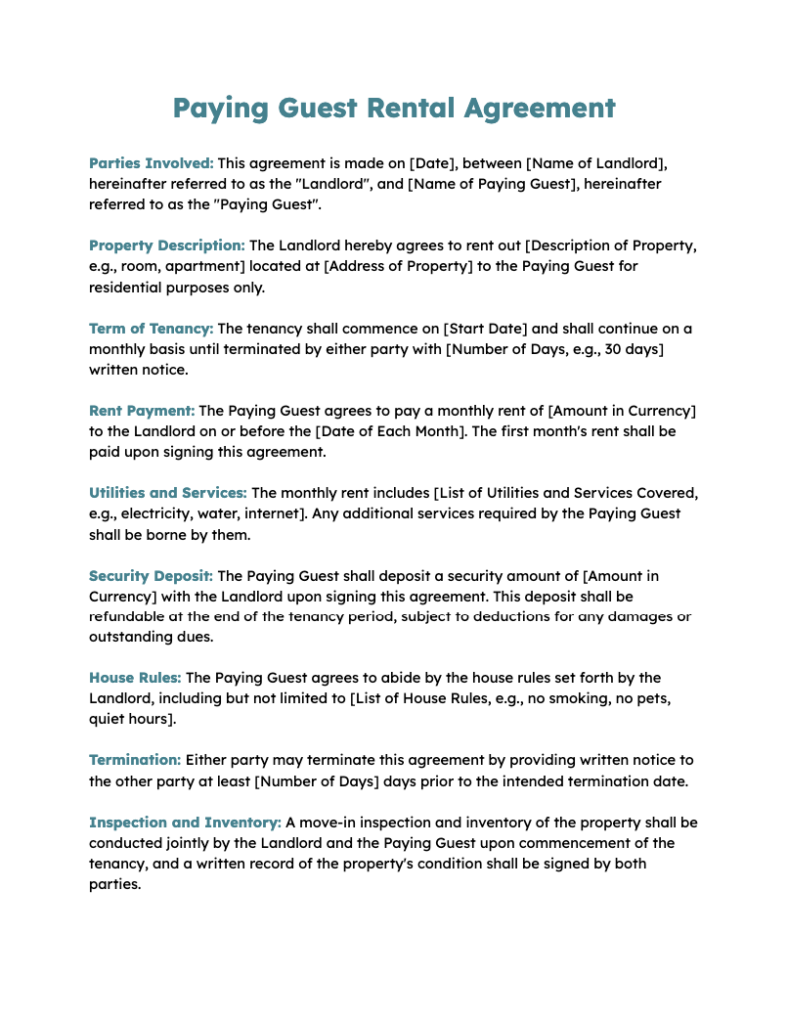
Paying Guest Rental Agreement
Parties Involved: This agreement is made on [Date], between [Name of Landlord], hereinafter referred to as the "Landlord", and [Name of Paying Guest], hereinafter referred to as the "Paying Guest".
Property Description: The Landlord hereby agrees to rent out [Description of Property, e.g., room, apartment] located at [Address of Property] to the Paying Guest for residential purposes only.
Term of Tenancy: The tenancy shall commence on [Start Date] and shall continue on a monthly basis until terminated by either party with [Number of Days, e.g., 30 days] written notice.
Rent Payment: The Paying Guest agrees to pay a monthly rent of [Amount in Currency] to the Landlord on or before the [Date of Each Month]. The first month's rent shall be paid upon signing this agreement.
Utilities and Services: The monthly rent includes [List of Utilities and Services Covered, e.g., electricity, water, internet]. Any additional services required by the Paying Guest shall be borne by them.
Security Deposit: The Paying Guest shall deposit a security amount of [Amount in Currency] with the Landlord upon signing this agreement. This deposit shall be refundable at the end of the tenancy period, subject to deductions for any damages or outstanding dues.
House Rules: The Paying Guest agrees to abide by the house rules set forth by the Landlord, including but not limited to [List of House Rules, e.g., no smoking, no pets, quiet hours].
Termination: Either party may terminate this agreement by providing written notice to the other party at least [Number of Days] days prior to the intended termination date.
Inspection and Inventory: A move-in inspection and inventory of the property shall be conducted jointly by the Landlord and the Paying Guest upon commencement of the tenancy, and a written record of the property's condition shall be signed by both parties.
Governing Law: This agreement shall be governed by and construed in accordance with the laws of [State/Country].
Signatures: The parties hereto have executed this agreement as of the date first above written.
[Signature of Landlord] [Signature of Paying Guest]
[Printed Name of Landlord] [Printed Name of Paying Guest]
Hostel Lease Agreement
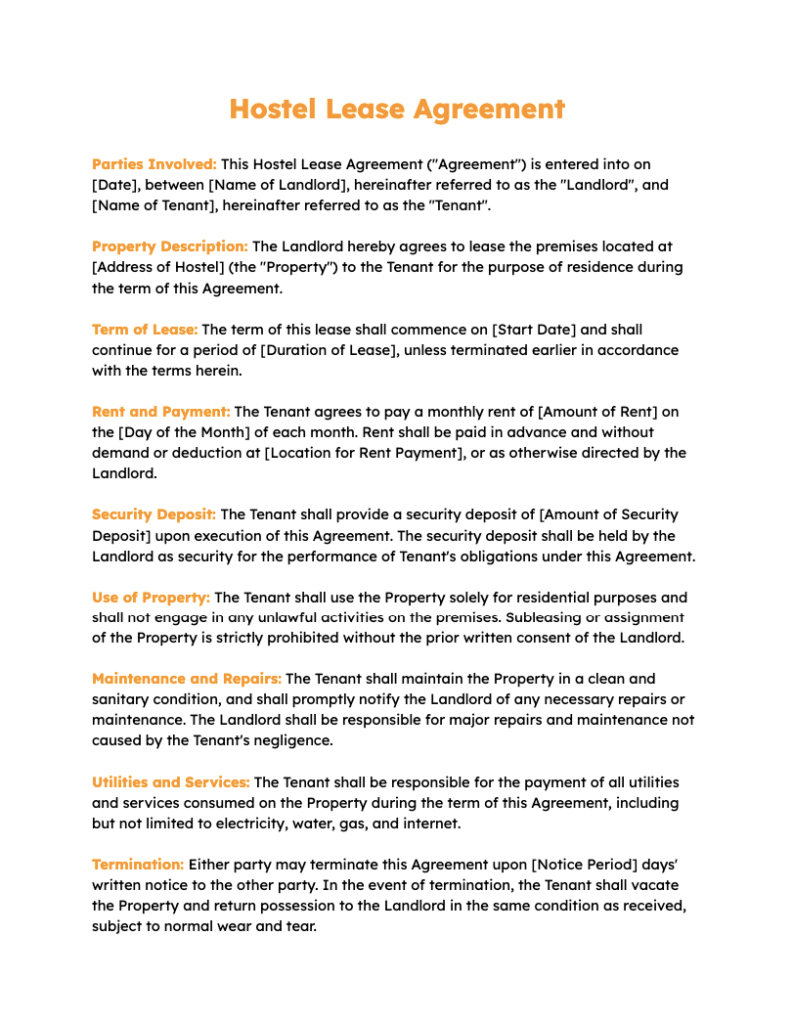
Hostel Lease Agreement
Parties Involved: This Hostel Lease Agreement ("Agreement") is entered into on [Date], between [Name of Landlord], hereinafter referred to as the "Landlord", and [Name of Tenant], hereinafter referred to as the "Tenant".
Property Description: The Landlord hereby agrees to lease the premises located at [Address of Hostel] (the "Property") to the Tenant for the purpose of residence during the term of this Agreement.
Term of Lease: The term of this lease shall commence on [Start Date] and shall continue for a period of [Duration of Lease], unless terminated earlier in accordance with the terms herein.
Rent and Payment: The Tenant agrees to pay a monthly rent of [Amount of Rent] on the [Day of the Month] of each month. Rent shall be paid in advance and without demand or deduction at [Location for Rent Payment], or as otherwise directed by the Landlord.
Security Deposit: The Tenant shall provide a security deposit of [Amount of Security Deposit] upon execution of this Agreement. The security deposit shall be held by the Landlord as security for the performance of Tenant's obligations under this Agreement.
Use of Property: The Tenant shall use the Property solely for residential purposes and shall not engage in any unlawful activities on the premises. Subleasing or assignment of the Property is strictly prohibited without the prior written consent of the Landlord.
Maintenance and Repairs: The Tenant shall maintain the Property in a clean and sanitary condition, and shall promptly notify the Landlord of any necessary repairs or maintenance. The Landlord shall be responsible for major repairs and maintenance not caused by the Tenant's negligence.
Utilities and Services: The Tenant shall be responsible for the payment of all utilities and services consumed on the Property during the term of this Agreement, including but not limited to electricity, water, gas, and internet.
Termination: Either party may terminate this Agreement upon [Notice Period] days' written notice to the other party. In the event of termination, the Tenant shall vacate the Property and return possession to the Landlord in the same condition as received, subject to normal wear and tear.
Governing Law: This Agreement shall be governed by and construed in accordance with the laws of [State/Country], and any disputes arising under or in connection with this Agreement shall be resolved exclusively by the courts of [Jurisdiction].
Entire Agreement: This Agreement constitutes the entire understanding between the parties concerning the lease of the Property and supersedes all prior agreements, whether oral or written.
IN WITNESS WHEREOF, the parties hereto have executed this Agreement as of the date first above written.
[Signature of Landlord] [Date]
[Signature of Tenant] [Date]
Temporary Rental Agreement

Temporary Rental Agreement
Parties Involved: This Temporary Rental Agreement ("Agreement") is entered into on [Date], between [Name of Landlord], hereinafter referred to as the "Landlord", and [Name of Tenant], hereinafter referred to as the "Tenant".
Property Description: The Landlord hereby agrees to lease the premises located at [Address of Rental Property] (the "Property") to the Tenant for temporary residential purposes during the term of this Agreement.
Term of Lease: The term of this lease shall commence on [Start Date] and shall continue for a period of [Duration of Lease], unless terminated earlier in accordance with the terms herein.
Rent and Payment: The Tenant agrees to pay a total rent of [Amount of Rent] for the entire term of this Agreement. Rent shall be paid in full upon execution of this Agreement and is non-refundable.
Use of Property: The Tenant shall use the Property solely for residential purposes and shall not engage in any unlawful activities on the premises. Subleasing or assignment of the Property is strictly prohibited without the prior written consent of the Landlord.
Utilities and Services: Unless otherwise specified, the Tenant shall be responsible for the payment of all utilities and services consumed on the Property during the term of this Agreement, including but not limited to electricity, water, gas, and internet.
Maintenance and Repairs: The Tenant shall maintain the Property in a clean and sanitary condition, and shall promptly notify the Landlord of any necessary repairs or maintenance. The Landlord shall be responsible for major repairs and maintenance not caused by the Tenant's negligence.
Termination: This Agreement shall automatically terminate upon the expiration of the term stated herein. The Tenant shall vacate the Property and return possession to the Landlord in the same condition as received, subject to normal wear and tear.
Governing Law: This Agreement shall be governed by and construed in accordance with the laws of [State/Country], and any disputes arising under or in connection with this Agreement shall be resolved exclusively by the courts of [Jurisdiction].
Entire Agreement: This Agreement constitutes the entire understanding between the parties concerning the temporary rental of the Property and supersedes all prior agreements, whether oral or written.
IN WITNESS WHEREOF, the parties hereto have executed this Agreement as of the date first above written.
[Signature of Landlord] [Date]
[Signature of Tenant] [Date]
11 Months Rental Agreement
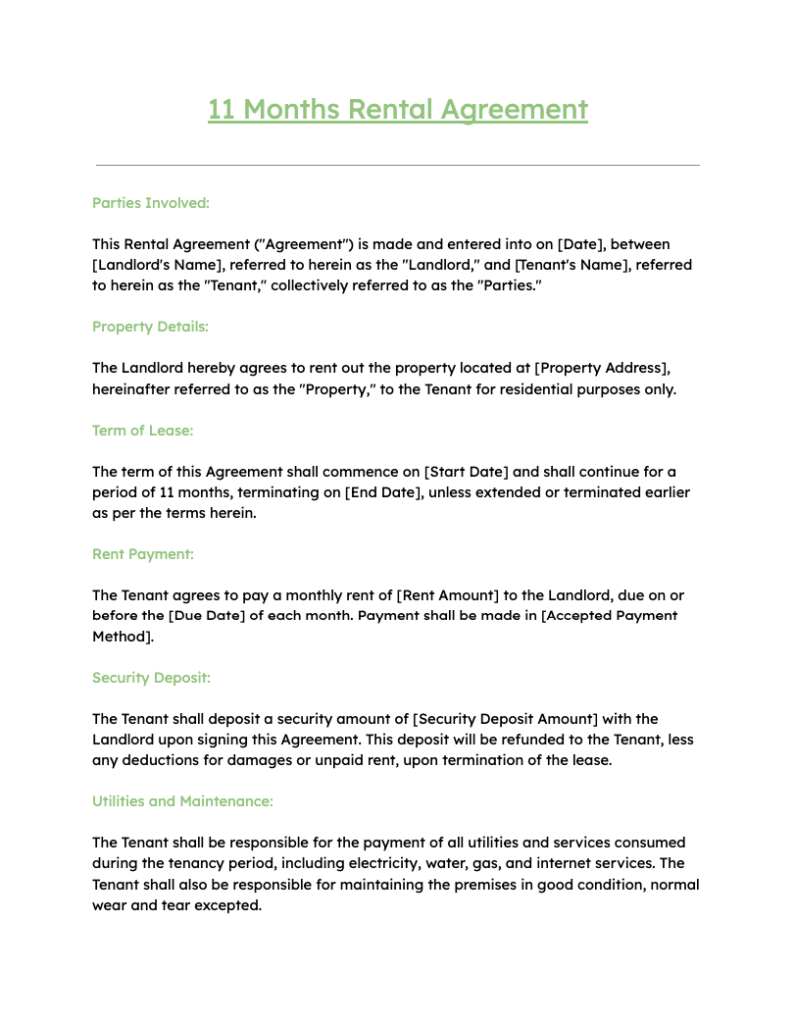
11 Months Rental Agreement
Parties Involved:
This Rental Agreement ("Agreement") is made and entered into on [Date], between [Landlord's Name], referred to herein as the "Landlord," and [Tenant's Name], referred to herein as the "Tenant," collectively referred to as the "Parties."
Property Details:
The Landlord hereby agrees to rent out the property located at [Property Address], hereinafter referred to as the "Property," to the Tenant for residential purposes only.
Term of Lease:
The term of this Agreement shall commence on [Start Date] and shall continue for a period of 11 months, terminating on [End Date], unless extended or terminated earlier as per the terms herein.
Rent Payment:
The Tenant agrees to pay a monthly rent of [Rent Amount] to the Landlord, due on or before the [Due Date] of each month. Payment shall be made in [Accepted Payment Method].
Security Deposit:
The Tenant shall deposit a security amount of [Security Deposit Amount] with the Landlord upon signing this Agreement. This deposit will be refunded to the Tenant, less any deductions for damages or unpaid rent, upon termination of the lease.
Utilities and Maintenance:
The Tenant shall be responsible for the payment of all utilities and services consumed during the tenancy period, including electricity, water, gas, and internet services. The Tenant shall also be responsible for maintaining the premises in good condition, normal wear and tear excepted.
Use of Property:
The Tenant agrees to use the Property solely for residential purposes and shall not sublet or assign the Property to any other individual or entity without the prior written consent of the Landlord.
Repairs and Alterations:
The Tenant shall promptly notify the Landlord of any repairs or maintenance issues that arise during the tenancy period. The Tenant shall not make any alterations or modifications to the Property without the Landlord's prior written consent.
Termination of Lease:
Either Party may terminate this Agreement with [Number of Days] days' written notice to the other Party. In the event of early termination, the Tenant shall be responsible for paying rent until the end of the notice period or until the Property is re-rented, whichever occurs first.
Governing Law:
This Agreement shall be governed by and construed in accordance with the laws of [State/Country], without regard to its conflicts of law principles.
Signatures:
Both Parties acknowledge that they have read and understood the terms and conditions of this Agreement and hereby affix their signatures as evidence of their acceptance.
[Signature of Landlord] [Signature of Tenant]
[Printed Name of Landlord] [Printed Name of Tenant]
Date: [Date]
Shared Room Rental Agreement Template
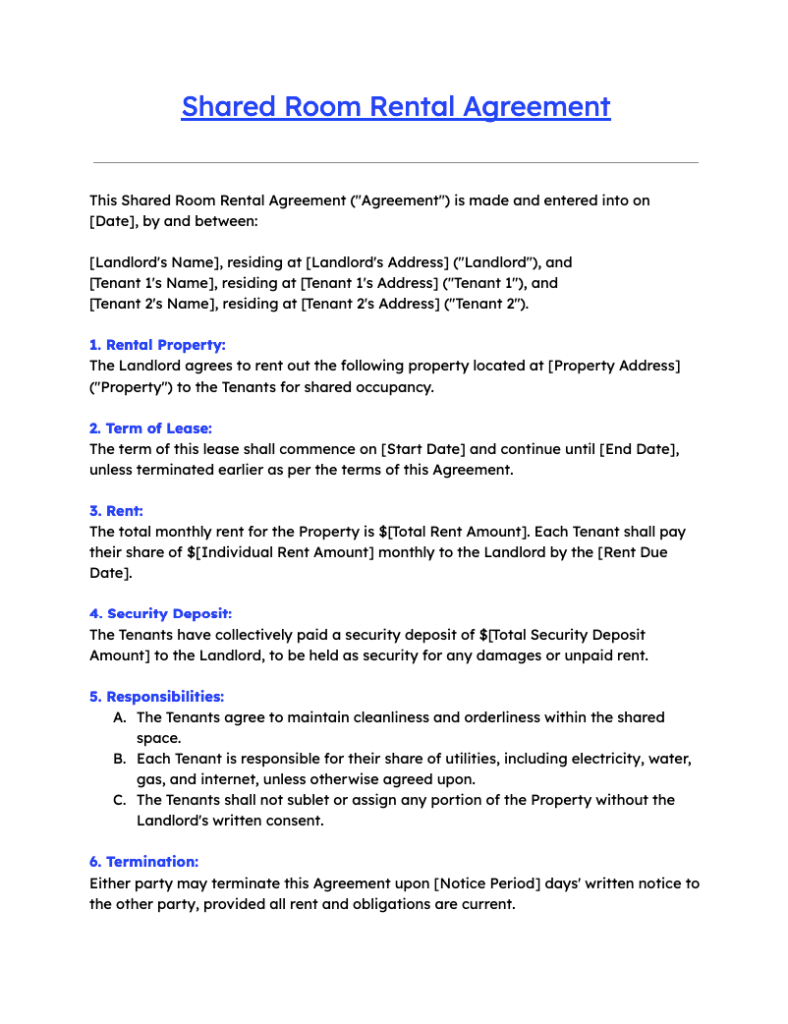
This Shared Room Rental Agreement ("Agreement") is made and entered into on [Date], by and between:
[Landlord's Name], residing at [Landlord's Address] ("Landlord"), and
[Tenant 1's Name], residing at [Tenant 1's Address] ("Tenant 1"), and
[Tenant 2's Name], residing at [Tenant 2's Address] ("Tenant 2").
1. Rental Property:
The Landlord agrees to rent out the following property located at [Property Address] ("Property") to the Tenants for shared occupancy.
2. Term of Lease:
The term of this lease shall commence on [Start Date] and continue until [End Date], unless terminated earlier as per the terms of this Agreement.
3. Rent:
The total monthly rent for the Property is $[Total Rent Amount]. Each Tenant shall pay their share of $[Individual Rent Amount] monthly to the Landlord by the [Rent Due Date].
4. Security Deposit:
The Tenants have collectively paid a security deposit of $[Total Security Deposit Amount] to the Landlord, to be held as security for any damages or unpaid rent.
5. Responsibilities:
a) The Tenants agree to maintain cleanliness and orderliness within the shared space.
b) Each Tenant is responsible for their share of utilities, including electricity, water, gas, and internet, unless otherwise agreed upon.
c) The Tenants shall not sublet or assign any portion of the Property without the Landlord's written consent.
6. Termination:
Either party may terminate this Agreement upon [Notice Period] days' written notice to the other party, provided all rent and obligations are current.
7. Governing Law:
This Agreement shall be governed by and construed in accordance with the laws of [State/Country].
8. Signatures:
The parties acknowledge that they have read and understood this Agreement and agree to abide by its terms.
Landlord: ________________________ Date: ______________
Tenant 1: ________________________ Date: ______________
Tenant 2: ________________________ Date: ______________
Official Lease Agreement Templates By State
Alaska Rental Agreement Template
Arizona
Arkansas
California Rental Agreement
Colorado Standard Lease Agreement
Connecticut Rental Lease Agreement
Delaware
Florida Lease Agreement
Georgia Property Lease Agreement Sample
Hawaii Rental Agreement
Idaho Lease Agreement
Illinois Rental Agreement
Indiana Residential Lease Agreement
Lowa Lease Agreement
Kansas Landlord Tenant Rental Agreement
Kentucky Lease Agreement
Louisiana Lease Agreement
Maine Residential Lease Agreement
Maryland Rental Agreement
Massachusetts Lease Agreement
Michigan Rental Agreement
Minnesota Lease Agreement
Mississippi Lease Agreement
Missouri Rental Agreement
Montana Lease Agreement
Nebraska
Nevada Lease Agreement
New Hampshire Lease Agreement
New Jersey Lease Agreement
New Mexico Lease Agreement
New York Lease Agreement
North Carolina Rental Contract
North Dakota Rental Agreement
Ohio Lease Agreement
Oklahoma Residential Lease Agreement
Oregon Lease Agreement
Pennsylvania Residential Lease Agreement
Rhode Island Lease Agreement
South Carolina Lease Agreement
South Dakota Lease Agreement
Tennessee Lease Agreement
Texas Residential Lease Agreement
Utah Lease Agreement
Vermont Lease Agreement
Virginia Lease Agreement
Washington Lease Agreement
West Virginia Contract of Lease
Wisconsin Lease Agreement
Wyoming Lease Agreement
Residential Lease Agreement Templates – for Landlords
Streamline landlord-tenant relationships with our Residential Lease Agreement Templates. Designed for landlords, these customizable templates ensure clarity and legality in rental arrangements. Simplify leasing while safeguarding your property and interests. Tailor agreements to property specifics and local regulations for peace of mind in every transaction.
Standard Lease Agreement
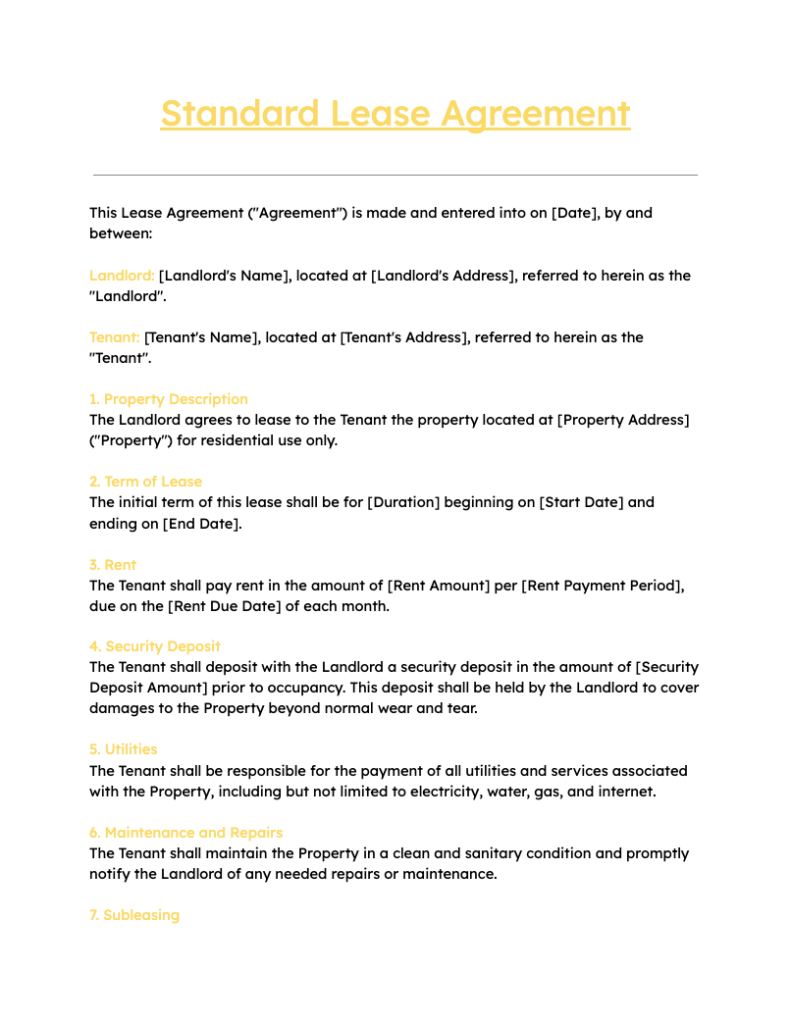
Standard Lease Agreement
This Lease Agreement ("Agreement") is made and entered into on [Date], by and between:
Landlord: [Landlord's Name], located at [Landlord's Address], referred to herein as the "Landlord".
Tenant: [Tenant's Name], located at [Tenant's Address], referred to herein as the "Tenant".
1. Property Description
The Landlord agrees to lease to the Tenant the property located at [Property Address] ("Property") for residential use only.
2. Term of Lease
The initial term of this lease shall be for [Duration] beginning on [Start Date] and ending on [End Date].
3. Rent
The Tenant shall pay rent in the amount of [Rent Amount] per [Rent Payment Period], due on the [Rent Due Date] of each month.
4. Security Deposit
The Tenant shall deposit with the Landlord a security deposit in the amount of [Security Deposit Amount] prior to occupancy. This deposit shall be held by the Landlord to cover damages to the Property beyond normal wear and tear.
5. Utilities
The Tenant shall be responsible for the payment of all utilities and services associated with the Property, including but not limited to electricity, water, gas, and internet.
6. Maintenance and Repairs
The Tenant shall maintain the Property in a clean and sanitary condition and promptly notify the Landlord of any needed repairs or maintenance.
7. Subleasing
The Tenant shall not sublease, assign, or transfer this lease agreement to any other party without the prior written consent of the Landlord.
8. Termination
Either party may terminate this lease agreement with [Notice Period] written notice to the other party.
9. Governing Law
This lease agreement shall be governed by and construed in accordance with the laws of [State/Country].
10. Entire Agreement
This Agreement constitutes the entire understanding between the parties and supersedes all prior agreements, whether written or oral.
IN WITNESS WHEREOF, the parties hereto have executed this Lease Agreement as of the date first above written.
Landlord:
[Landlord's Signature]
[Printed Name of Landlord]
Tenant:
[Tenant's Signature]
[Printed Name of Tenant]
Month to Month Lease Agreement
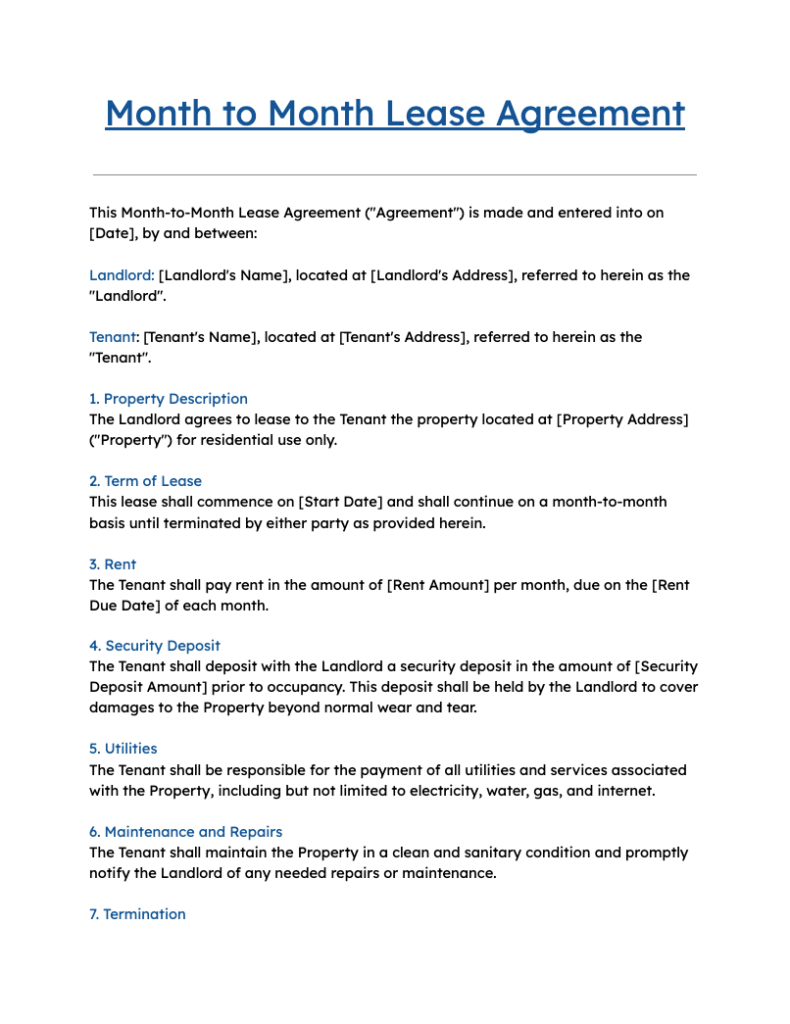
This Month-to-Month Lease Agreement ("Agreement") is made and entered into on [Date], by and between:
Landlord: [Landlord's Name], located at [Landlord's Address], referred to herein as the "Landlord".
Tenant: [Tenant's Name], located at [Tenant's Address], referred to herein as the "Tenant".
1. Property Description
The Landlord agrees to lease to the Tenant the property located at [Property Address] ("Property") for residential use only.
2. Term of Lease
This lease shall commence on [Start Date] and shall continue on a month-to-month basis until terminated by either party as provided herein.
3. Rent
The Tenant shall pay rent in the amount of [Rent Amount] per month, due on the [Rent Due Date] of each month.
4. Security Deposit
The Tenant shall deposit with the Landlord a security deposit in the amount of [Security Deposit Amount] prior to occupancy. This deposit shall be held by the Landlord to cover damages to the Property beyond normal wear and tear.
5. Utilities
The Tenant shall be responsible for the payment of all utilities and services associated with the Property, including but not limited to electricity, water, gas, and internet.
6. Maintenance and Repairs
The Tenant shall maintain the Property in a clean and sanitary condition and promptly notify the Landlord of any needed repairs or maintenance.
7. Termination
Either party may terminate this lease agreement with [Notice Period] written notice to the other party.
8. Governing Law
This lease agreement shall be governed by and construed in accordance with the laws of [State/Country].
9. Entire Agreement
This Agreement constitutes the entire understanding between the parties and supersedes all prior agreements, whether written or oral.
IN WITNESS WHEREOF, the parties hereto have executed this Month-to-Month Lease Agreement as of the date first above written.
Landlord:
[Landlord's Signature]
[Printed Name of Landlord]
Tenant:
[Tenant's Signature]
[Printed Name of Tenant]
Short Term (Vacation) Lease Agreement

Short Term (Vacation) Lease Agreement
This Short-Term Vacation Lease Agreement (the "Agreement") is made and entered into by and between [Property Owner's Name] (the "Owner") and [Tenant's Name] (the "Tenant") as of [Date of Agreement].
Property Description:
The Owner agrees to lease to the Tenant, and the Tenant agrees to rent from the Owner, the property located at [Address of Property], hereinafter referred to as the "Property".
Rental Term:
The rental term shall commence on [Start Date] at [Check-in Time] and end on [End Date] at [Check-out Time].
Rent Payment:
The Tenant agrees to pay a total rent of [Rent Amount] for the entire stay. The full rent amount shall be paid in advance on or before the commencement of the rental term.
Security Deposit:
The Tenant shall provide a security deposit of [Security Deposit Amount] upon signing this Agreement. The security deposit will be refunded within [Number of Days] days of the end of the rental term, less any deductions for damages, excessive cleaning, or violations of this Agreement.
House Rules:
The Tenant agrees to abide by all house rules set forth by the Owner, including but not limited to:
No smoking inside the Property.
No pets allowed unless otherwise agreed upon.
Quiet hours from [Start Time] to [End Time].
Any other rules specified by the Owner.
Maintenance and Repairs:
The Owner shall be responsible for maintaining the Property in a habitable condition throughout the rental term. The Tenant agrees to promptly report any maintenance issues or damages to the Owner.
Utilities and Services:
[Specify which utilities and services are included in the rent (e.g., electricity, water, internet) and any additional charges, if applicable.]
Occupancy Limits:
The maximum number of guests allowed to stay in the Property is [Maximum Number of Guests]. Subleasing or hosting events at the Property is strictly prohibited without prior written consent from the Owner.
Termination of Agreement:
Either party may terminate this Agreement by providing [Number of Days] days' written notice to the other party. In the event of early termination, the Tenant shall forfeit any prepaid rent unless otherwise agreed upon.
Governing Law:
This Agreement shall be governed by and construed in accordance with the laws of [State/Country].
IN WITNESS WHEREOF, the parties hereto have executed this Agreement as of the date first above written.
[Owner's Signature] [Tenant's Signature]
[Owner's Name] [Tenant's Name]
[Date] [Date]
[Your Company Name]
[Your Company Address]
[Your Company Contact Information]
Rent to Own Agreement

Parties Involved:
Landlord: [Full Name]
Address: [Landlord's Address]
Tenant: [Full Name]
Address: [Tenant's Address]
Property Details:
Address of Property: [Property Address]
Description of Property: [Brief Description]
Amenities Included: [List Amenities, if any]
Rental Terms:
Monthly Rent Amount: [Rent Amount]
Lease Term: [Duration of Lease]
Start Date: [Lease Start Date]
End Date: [Lease End Date]
Option to Purchase:
Purchase Price: [Agreed Upon Purchase Price]
Option Fee (if applicable): [Amount, if any]
Option Period: [Duration of Option Period]
Terms of Purchase: [Include any terms related to the purchase]
Maintenance and Repairs:
Responsibilities of Landlord: [Specify Landlord's Responsibilities]
Responsibilities of Tenant: [Specify Tenant's Responsibilities]
Insurance:
Landlord's Insurance: [Details of Landlord's Insurance Coverage]
Tenant's Insurance: [Details of Tenant's Insurance Coverage]
Default and Termination:
Conditions for Default: [Specify Conditions]
Termination Process: [Outline Termination Process]
Miscellaneous Provisions:
Governing Law: [State the Governing Law]
Entire Agreement: [State that this Agreement constitutes the entire agreement between the parties]
Signatures:
Landlord's Signature: _____________________ Date: ___________
Tenant's Signature: _____________________ Date: ___________
Lease Extension Agreement

This Lease Extension Agreement ("Agreement") is made and entered into on [Date], by and between:
[Landlord's Name], ("Landlord"), having an address at [Landlord's Address],
and
[Tenant's Name], ("Tenant"), having an address at [Tenant's Address],
collectively referred to as the "Parties."
Background:
Whereas, Landlord and Tenant entered into a lease agreement dated [Original Lease Date], ("Original Lease"), for the property located at [Property Address];
Whereas, the Original Lease is set to expire on [Original Lease End Date];
Whereas, both parties desire to extend the term of the lease agreement under the terms and conditions set forth herein.
Agreement:
Extension of Lease Term: The term of the Original Lease is hereby extended for an additional period of [Extension Term] beginning on [New Lease Start Date] and ending on [New Lease End Date].
Rent: During the Extension Term, Tenant shall pay rent in the amount of [New Rent Amount] per [Rent Payment Frequency], payable in accordance with the terms of the Original Lease.
Other Terms: Except as expressly modified herein, all other terms and conditions of the Original Lease shall remain in full force and effect during the Extension Term.
Security Deposit: The security deposit held under the Original Lease in the amount of [Original Security Deposit Amount] shall continue to serve as security for Tenant's performance of its obligations under this Agreement.
Execution: This Agreement may be executed in counterparts, each of which shall be deemed an original and all of which shall constitute one and the same instrument.
IN WITNESS WHEREOF, the Parties have executed this Lease Extension Agreement as of the date first above written.
Landlord:
[Landlord's Signature]
[Date]
Tenant:
[Tenant's Signature]
[Date]
Lease renewal agreement
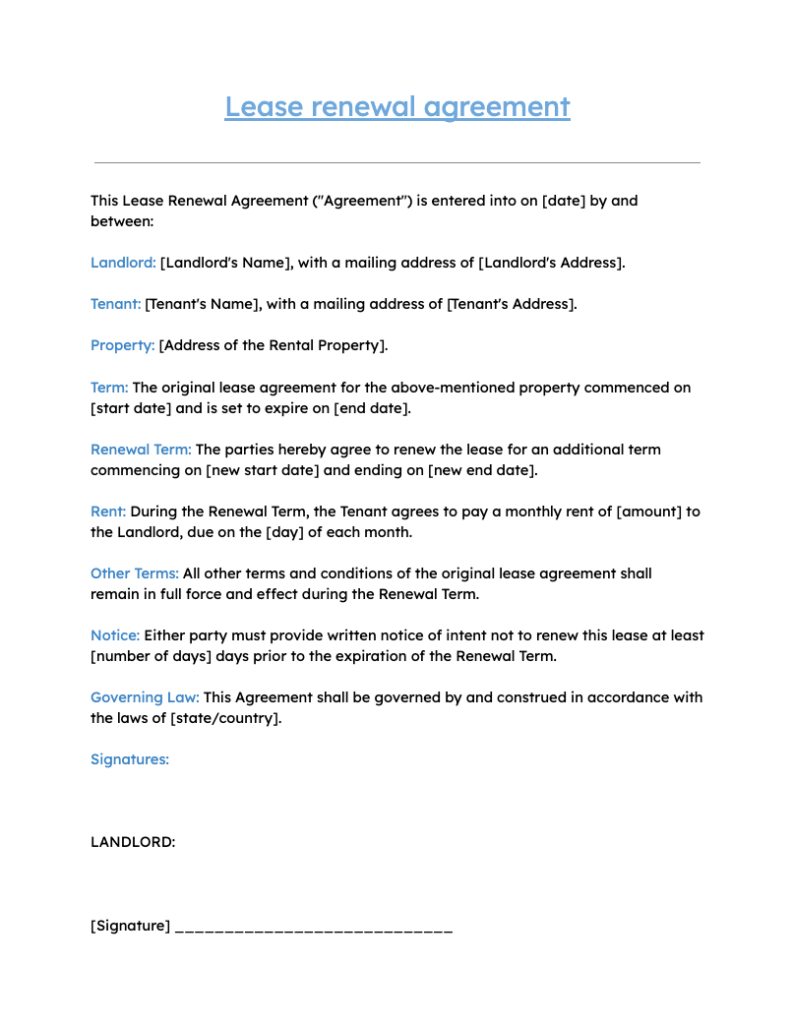
This Lease Renewal Agreement ("Agreement") is entered into on [date] by and between:
Landlord: [Landlord's Name], with a mailing address of [Landlord's Address].
Tenant: [Tenant's Name], with a mailing address of [Tenant's Address].
Property: [Address of the Rental Property].
Term: The original lease agreement for the above-mentioned property commenced on [start date] and is set to expire on [end date].
Renewal Term: The parties hereby agree to renew the lease for an additional term commencing on [new start date] and ending on [new end date].
Rent: During the Renewal Term, the Tenant agrees to pay a monthly rent of [amount] to the Landlord, due on the [day] of each month.
Other Terms: All other terms and conditions of the original lease agreement shall remain in full force and effect during the Renewal Term.
Notice: Either party must provide written notice of intent not to renew this lease at least [number of days] days prior to the expiration of the Renewal Term.
Governing Law: This Agreement shall be governed by and construed in accordance with the laws of [state/country].
Signatures:
LANDLORD:
[Signature] ____________________________
[Tenant's Name] (Landlord)
Date: ____________________________
TENANT:
[Signature] ____________________________
[Tenant's Name]
Date: ____________________________
Sublease Agreement Templates [For Tenants]
Effortlessly sublet your space with our Sublease Agreement Templates for tenants. Crafted for subleasing scenarios, these templates ensure legal compliance and clarity in rental arrangements. Simplify the process while protecting your interests and property. Customize agreements to suit your specific subleasing needs and local regulations for a seamless transaction.
Sublease Agreement

This Sublease Agreement ("Agreement") is made on [date], between:
Sublessor: [Name of Sublessor], referred to as "Sublessor", with a mailing address of [Sublessor's Address].
Sublessee: [Name of Sublessee], referred to as "Sublessee", with a mailing address of [Sublessee's Address].
Original Lease Agreement: This sublease is for the property located at [Address of the Property], which is currently leased by the Sublessor from the Original Landlord under the terms of the lease dated [date of original lease].
Term: The sublease shall commence on [start date] and terminate on [end date], unless terminated earlier in accordance with the terms of this Agreement or the original lease.
Rent: The Sublessee agrees to pay a monthly rent of [amount] to the Sublessor, due on the [day] of each month.
Security Deposit: The Sublessee shall provide a security deposit of [amount] to the Sublessor upon signing this Agreement.
Sublease Terms: The Sublessee agrees to abide by all terms and conditions of the original lease agreement between the Sublessor and the Original Landlord.
Maintenance and Repairs: The Sublessee shall be responsible for maintaining the property in good condition and shall promptly notify the Sublessor of any necessary repairs.
Assignment and Subletting: The Sublessee shall not assign this sublease or sublet the premises without the prior written consent of the Sublessor.
Termination: Either party may terminate this sublease with [number of days] days' written notice to the other party.
Governing Law: This Agreement shall be governed by and construed in accordance with the laws of [state/country].
Signatures:
SUBLESSOR:
[Signature] ____________________________
[Sublessor's Name]
Date: ____________________________
SUBLESSEE:
[Signature] ____________________________
[Sublessee's Name]
Date: ____________________________
Room Rental Agreement

This Room Rental Agreement ("Agreement") is made on [date], between:
Landlord: [Name of Landlord], referred to as "Landlord", with a mailing address of [Landlord's Address].
Tenant: [Name of Tenant], referred to as "Tenant", with a mailing address of [Tenant's Address].
Room: This agreement pertains to the room located at [Address of the Property], within the premises owned by the Landlord.
Term: The rental period shall commence on [start date] and terminate on [end date], unless terminated earlier in accordance with the terms of this Agreement.
Rent: The Tenant agrees to pay a monthly rent of [amount] to the Landlord, due on the [day] of each month.
Security Deposit: The Tenant shall provide a security deposit of [amount] to the Landlord upon signing this Agreement.
Use of Common Areas: The Tenant shall have access to and use of common areas such as the kitchen, living room, and bathroom, in addition to the rented room.
Utilities: The Tenant's rent includes/excludes utilities such as electricity, water, and internet, as specified in Schedule A attached hereto.
Maintenance and Repairs: The Tenant shall keep the rented room and common areas clean and in good condition. The Landlord shall be responsible for major repairs and maintenance.
Guests: The Tenant may have guests stay overnight for a maximum of [number] nights per week with prior consent from the Landlord.
Termination: Either party may terminate this Agreement with [number of days] days' written notice to the other party.
Governing Law: This Agreement shall be governed by and construed in accordance with the laws of [state/country].
Signatures:
LANDLORD:
[Signature] ____________________________
[Landlord's Name]
Date: ____________________________
TENANT:
[Signature] ____________________________
[Tenant's Name]
Date: ____________________________
Roommate Agreement

This Roommate Agreement ("Agreement") is entered into on [date], by and between the following tenants:
Names of Tenants: [List names of all tenants]
1. Rent and Utilities:
Rent Payment: Each tenant agrees to pay their share of the rent promptly by [date] of each month.
Utilities: The tenants agree to split utilities such as electricity, water, gas, and internet equally, unless otherwise agreed upon.
2. Security Deposit:
Initial Deposit: Each tenant has contributed [amount] towards the security deposit.
Return of Deposit: The deposit will be returned within [number] days of termination of the lease, minus any deductions for damages.
3. Living Arrangements:
Bedroom Allocation: The tenants have agreed upon the allocation of bedrooms as follows: [describe bedroom allocation].
Common Areas: The tenants will share common areas including the living room, kitchen, and bathrooms, and agree to keep these areas clean and tidy.
4. Guest Policy:
Guests: Tenants must inform each other in advance if they plan to have overnight guests.
Duration: Overnight guests are allowed for a maximum of [number] consecutive nights.
5. Quiet Hours and Respect:
Quiet Hours: Quiet hours are from [time] to [time] on weekdays and [time] to [time] on weekends.
Respect: Tenants agree to respect each other's privacy, property, and schedules.
6. Maintenance and Repairs:
Reporting: Tenants agree to promptly report any maintenance issues or repairs needed to the landlord.
Responsibility: Tenants will be responsible for any damages caused by negligence or misuse.
7. Termination:
Notice Period: If a tenant wishes to terminate this Agreement, they must provide [number] days' notice to the other tenants.
Replacement Tenant: The departing tenant agrees to assist in finding a replacement tenant if necessary.
8. Additional Terms:
[Any additional terms agreed upon by the tenants should be listed here.]
9. Signatures:
The parties hereby acknowledge that they have read and understood this Agreement and agree to abide by its terms.
Signed:
[Signature of Tenant 1] [Signature of Tenant 2]
[Signature of Tenant 3] [Signature of Tenant 4]
Commercial Lease Agreement Templates
Facilitate smooth landlord-tenant relationships with our Commercial Lease Agreement Templates. Tailored for commercial properties, these templates ensure legal compliance and clarity in lease arrangements. Simplify the leasing process while safeguarding your interests and property. Customize agreements to fit specific commercial needs and local regulations for seamless transactions.
Commercial Lease Agreement
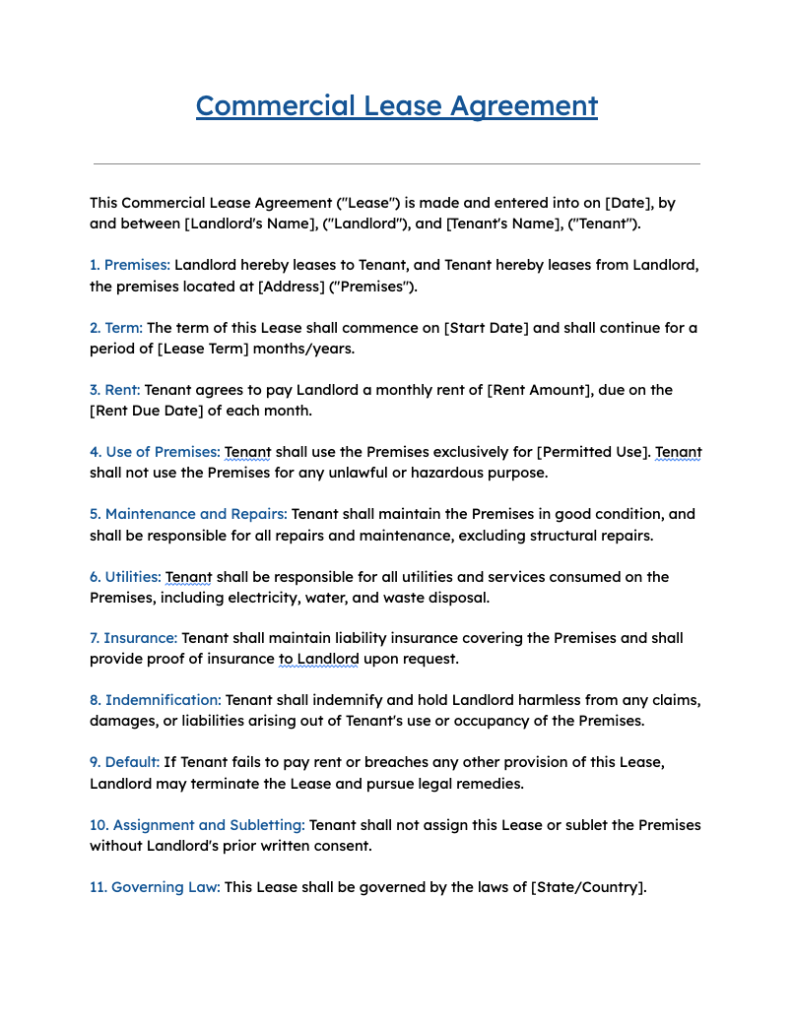
This Commercial Lease Agreement ("Lease") is made and entered into on [Date], by and between [Landlord's Name], ("Landlord"), and [Tenant's Name], ("Tenant").
1. Premises: Landlord hereby leases to Tenant, and Tenant hereby leases from Landlord, the premises located at [Address] ("Premises").
2. Term: The term of this Lease shall commence on [Start Date] and shall continue for a period of [Lease Term] months/years.
3. Rent: Tenant agrees to pay Landlord a monthly rent of [Rent Amount], due on the [Rent Due Date] of each month.
4. Use of Premises: Tenant shall use the Premises exclusively for [Permitted Use]. Tenant shall not use the Premises for any unlawful or hazardous purpose.
5. Maintenance and Repairs: Tenant shall maintain the Premises in good condition, and shall be responsible for all repairs and maintenance, excluding structural repairs.
6. Utilities: Tenant shall be responsible for all utilities and services consumed on the Premises, including electricity, water, and waste disposal.
7. Insurance: Tenant shall maintain liability insurance covering the Premises and shall provide proof of insurance to Landlord upon request.
8. Indemnification: Tenant shall indemnify and hold Landlord harmless from any claims, damages, or liabilities arising out of Tenant's use or occupancy of the Premises.
9. Default: If Tenant fails to pay rent or breaches any other provision of this Lease, Landlord may terminate the Lease and pursue legal remedies.
10. Assignment and Subletting: Tenant shall not assign this Lease or sublet the Premises without Landlord's prior written consent.
11. Governing Law: This Lease shall be governed by the laws of [State/Country].
IN WITNESS WHEREOF, the parties hereto have executed this Lease as of the date first above written.
[Landlord's Signature] [Tenant's Signature]
Land Lease Agreement

Parties:
This Land Lease Agreement (the "Agreement") is made and entered into this [insert date], by and between [Landowner's Name], hereinafter referred to as the "Landowner", and [Tenant's Name], hereinafter referred to as the "Tenant".
Premises:
The Landowner hereby agrees to lease to the Tenant, and the Tenant hereby agrees to lease from the Landowner, the following described real property located at [insert address or legal description of the land] (the "Property").
Term:
The term of this Agreement shall commence on [insert start date] and shall continue for a period of [insert duration of the lease], unless earlier terminated pursuant to the terms herein.
Rent:
The Tenant shall pay to the Landowner a monthly rent of [insert amount] payable in advance on the [insert day] of each month.
Use of Premises:
The Tenant shall use the Property solely for [insert specific purpose or permitted uses] and shall comply with all applicable laws, ordinances, rules, and regulations.
Maintenance and Repairs:
The Tenant shall be responsible for all maintenance and repairs to the Property, including but not limited to landscaping, snow removal, and any structural repairs necessitated by the Tenant's use of the Property.
Utilities:
The Tenant shall be responsible for all utilities and services used on the Property, including but not limited to water, electricity, gas, and trash removal.
Insurance:
The Tenant shall maintain liability insurance coverage for its use of the Property and shall provide proof of such insurance to the Landowner upon request.
Indemnification:
The Tenant shall indemnify and hold harmless the Landowner from and against any and all claims, damages, liabilities, and expenses arising out of or related to the Tenant's use of the Property.
Assignment and Subletting:
The Tenant shall not assign, sublease, or otherwise transfer its interest in this Agreement without the prior written consent of the Landowner.
Termination:
Either party may terminate this Agreement upon [insert notice period] written notice to the other party for any reason or no reason at all.
Governing Law:
This Agreement shall be governed by and construed in accordance with the laws of [insert jurisdiction].
IN WITNESS WHEREOF, the parties hereto have executed this Agreement as of the date first above written.
[Signature lines for Landowner and Tenant]
Equipment Lease Agreement
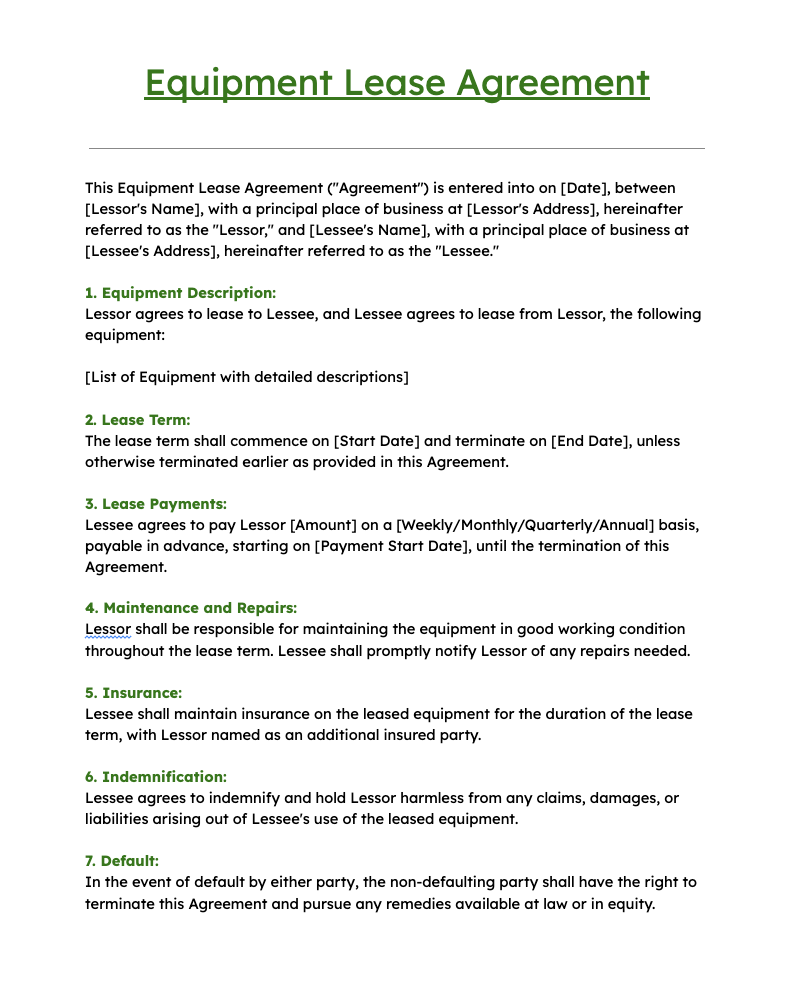
This Equipment Lease Agreement ("Agreement") is entered into on [Date], between [Lessor's Name], with a principal place of business at [Lessor's Address], hereinafter referred to as the "Lessor," and [Lessee's Name], with a principal place of business at [Lessee's Address], hereinafter referred to as the "Lessee."
1. Equipment Description:
Lessor agrees to lease to Lessee, and Lessee agrees to lease from Lessor, the following equipment:
[List of Equipment with detailed descriptions]
2. Lease Term:
The lease term shall commence on [Start Date] and terminate on [End Date], unless otherwise terminated earlier as provided in this Agreement.
3. Lease Payments:
Lessee agrees to pay Lessor [Amount] on a [Weekly/Monthly/Quarterly/Annual] basis, payable in advance, starting on [Payment Start Date], until the termination of this Agreement.
4. Maintenance and Repairs:
Lessor shall be responsible for maintaining the equipment in good working condition throughout the lease term. Lessee shall promptly notify Lessor of any repairs needed.
5. Insurance:
Lessee shall maintain insurance on the leased equipment for the duration of the lease term, with Lessor named as an additional insured party.
6. Indemnification:
Lessee agrees to indemnify and hold Lessor harmless from any claims, damages, or liabilities arising out of Lessee's use of the leased equipment.
7. Default:
In the event of default by either party, the non-defaulting party shall have the right to terminate this Agreement and pursue any remedies available at law or in equity.
8. Governing Law:
This Agreement shall be governed by and construed in accordance with the laws of [State/Country], without regard to its conflict of law principles.
9. Entire Agreement:
This Agreement constitutes the entire understanding between the parties concerning the subject matter hereof and supersedes all prior agreements and understandings, whether written or oral.
10. Signatures:
Both parties acknowledge that they have read and understood this Agreement and agree to be bound by its terms.
Lessor's Signature:
[Signature]
Lessee's Signature:
[Signature]
Parking Space Rental Agreement

Effective Date: [Date]
Parties:
This Parking Space Rental Agreement ("Agreement") is made and entered into by and between:
Landlord: [Your Name/Business Name], with a mailing address of [Your Address]
Tenant: [Tenant's Name], with a mailing address of [Tenant's Address]
Parking Space Details:
Location: The parking space is located at [Address of Parking Space].
Description: [Description of the parking space, e.g., numbered space, covered or uncovered, etc.].
Term: The rental term shall commence on [Start Date] and shall continue on a month-to-month basis until terminated by either party with [X days/weeks] written notice.
Rent: The monthly rent for the parking space is [Amount] payable in advance on the [Date of each month].
Security Deposit: Tenant shall pay a security deposit of [Amount] upon signing this Agreement, which shall be returned within [X] days of termination, less any deductions for damages or unpaid rent.
Use: The parking space is for the sole use of Tenant for parking one [Description of vehicle], and no other purpose.
Rules and Regulations: Tenant agrees to abide by any rules and regulations set forth by the Landlord regarding the use of the parking space.
Termination:
Either party may terminate this Agreement by providing [X days/weeks] written notice to the other party.
Indemnification:
Tenant agrees to indemnify and hold harmless Landlord from any claims, damages, or liabilities arising out of Tenant's use of the parking space.
Governing Law:
This Agreement shall be governed by and construed in accordance with the laws of [Your State/Country].
Signatures:
Landlord: ___________________________ Date: _______________
Tenant: ___________________________ Date: _______________
Disclosures & Addendums
Access a comprehensive array of Disclosures & Addendums templates essential for rental agreements. Covering a wide range of scenarios, these templates ensure legal compliance and address specific property concerns. Simplify the leasing process by supplementing your lease agreements with customizable disclosures and addendums tailored to your unique requirements and local regulations. Safeguard your interests and property with ease.
Evictions

[Your Name] [Tenant’s Name]
[Your Address] [Tenant’s Address]
[City, State, Zip Code] [City, State, Zip Code]
[Phone Number]
[Email Address]
[Date]
Dear [Tenant’s Name],
This notice serves as formal notification of eviction from the premises located at [Address of Rental Property]. Despite previous discussions and attempts to rectify the situation, it has become evident that the terms of the rental agreement have not been upheld.
[Provide brief explanation for eviction, such as non-payment of rent, violation of lease terms, etc.]
As a result, you are hereby required to vacate the premises and surrender possession to the landlord within [Number of Days to Vacate] days from the date of this notice. Failure to comply with this directive will result in further legal action to enforce eviction proceedings.
Please ensure that all personal belongings are removed from the premises prior to the specified vacate date. Any items remaining after this time may be considered abandoned and disposed of accordingly.
Should you have any questions or require further clarification regarding this matter, please do not hesitate to contact our office at [Your Phone Number] or [Your Email Address].
Your cooperation in this matter is greatly appreciated.
Sincerely,
[Your Name]
[Your Signature (if sending a physical letter)]
[Date]
Commercial Lease Agreement Addendum

Amendment Overview:
This Addendum ("Addendum") is hereby incorporated into the Commercial Lease Agreement dated [Original Lease Date], between [Landlord's Name], hereinafter referred to as "Landlord", and [Tenant's Name], hereinafter referred to as "Tenant". The purpose of this Addendum is to modify and supplement specific terms of the original Lease Agreement.
Parties Involved:
Landlord: [Landlord's Legal Name]
Address: [Landlord's Address]
Tenant: [Tenant's Legal Name]
Address: [Tenant's Address]
Reference to Original Lease:
This Addendum pertains to the Commercial Lease Agreement executed between the Landlord and Tenant on [Original Lease Date], a copy of which is attached hereto and incorporated herein by reference.
Amendments:
Term Extension: The term of the lease agreement shall be extended for an additional [Specify Duration] months, commencing from [New Lease Start Date] and terminating on [New Lease End Date].
Rent Adjustment: The monthly rent shall be adjusted to [New Rent Amount] starting from [Effective Date of Rent Adjustment].
Maintenance Responsibilities: The Tenant shall now be responsible for [Specify Maintenance Responsibilities] in addition to the existing maintenance obligations outlined in the original Lease Agreement.
Terms and Conditions:
All other terms and conditions of the original Lease Agreement not modified by this Addendum shall remain in full force and effect.
Signatures:
In witness whereof, the parties hereto have executed this Addendum as of the date first above written.
Landlord: ___________________________ Date: _______________
Tenant: _____________________________ Date: _______________
Residential Lease Agreement Addendum

This Residential Lease Agreement Addendum ("Addendum") is made on [insert date] between [Landlord's Name], hereinafter referred to as "Landlord," and [Tenant's Name], hereinafter referred to as "Tenant," collectively referred to as the "Parties."
1. Additional Terms:
1.1 Pets: The Parties agree to amend the original lease agreement dated [insert date] to include the following provisions regarding pets:
Tenant is allowed to keep [number of pets] pet(s) on the premises.
Tenant agrees to pay a pet deposit of [amount] in addition to the security deposit mentioned in the original lease agreement.
Tenant agrees to be responsible for any damages caused by the pet(s) to the rental property and its surroundings.
1.2 Utilities: The Parties agree to amend the original lease agreement to include the following provision regarding utilities:
[Specify any changes or additional responsibilities regarding utilities, such as who is responsible for paying for specific utilities or any changes in utility arrangements.]
1.3 Subleasing: The Parties agree to amend the original lease agreement to include the following provision regarding subleasing:
Tenant is prohibited from subleasing the rental property to any third party without prior written consent from the Landlord.
2. Incorporation:
This Addendum is hereby incorporated into the original lease agreement dated [insert date]. All other terms and conditions of the original lease agreement shall remain in full force and effect.
3. Signatures:
The Parties acknowledge that they have read and understood this Addendum and agree to be bound by its terms and conditions.
Landlord: ___________________________ Date: _______________
Tenant: ___________________________ Date: _______________
Lease Agreement Amendment

[Your Business Name] Lease Agreement Amendment
This Lease Agreement Amendment ("Amendment") is made on [Date], between [Landlord's Name], ("Landlord") and [Tenant's Name], ("Tenant"), regarding the property located at [Property Address].
1. Background
Whereas, Landlord and Tenant entered into a lease agreement dated [Original Lease Agreement Date], ("Lease Agreement"), for the property located at [Property Address].
2. Amendment
Landlord and Tenant hereby agree to amend the Lease Agreement as follows:
Paragraph/Section: [Specify the paragraph or section to be amended]
Current Language: [Provide the current language of the paragraph or section]
Amended Language: [Provide the amended language of the paragraph or section]
3. Effective Date
This Amendment shall be effective as of [Effective Date].
4. Entire Agreement
This Amendment constitutes the entire agreement between the parties concerning the subject matter hereof and supersedes all prior agreements and understandings, whether written or oral.
5. Counterparts
This Amendment may be executed in counterparts, each of which shall be deemed an original, but all of which together shall constitute one and the same instrument.
IN WITNESS WHEREOF, the parties have executed this Amendment as of the date first above written.
[Landlord's Name]
By: ____________________________
Name: __________________________
Title: ___________________________
[Tenant's Name]
By: ____________________________
Name: __________________________
Title: ___________________________
Rental Inspection Checklist

Property Details:
Address: ____________________________
Tenant Name: ________________________
Date of Inspection: ___________________
Exterior:
Landscaping: Trimmed and well-maintained
Exterior Walls: No cracks or signs of damage
Roof: No missing shingles or leaks
Windows and Doors: Properly sealed and functioning
Interior:
Living Areas:
Walls and Ceilings: No cracks or water stains
Flooring: Clean and free of damage
Windows: Open and close smoothly, no broken panes
Kitchen:
Appliances: Functioning properly (check stove, refrigerator, dishwasher)
Countertops and Cabinets: No damage or signs of wear
Sink and Faucet: No leaks, drains properly
Bathroom:
Toilet: Flushes properly, no leaks
Sink and Faucet: No leaks, drains properly
Shower/Bathtub: No leaks, drains properly
Bedrooms:
Walls and Ceilings: No cracks or water stains
Flooring: Clean and free of damage
Closet: Doors function properly, no signs of damage
Safety Features:
Smoke Detectors: Installed and functional
Carbon Monoxide Detectors: Installed and functional
Fire Extinguisher: Accessible and not expired
Additional Notes:
(Use this space to note any additional observations or maintenance tasks)
Tenant Signature:
I acknowledge that the above items have been inspected, and I am aware of any necessary repairs or maintenance.
Signature: _______________________
Date: ___________________________
Landlord/Property Manager Signature:
I acknowledge that the above items have been inspected and agree to address any necessary repairs or maintenance in a timely manner.
Signature: _______________________
Date: ___________________________
Rent Receipt

Rent Receipt
Date: __________________
Received from: __________________
Address of Rental Property: ________________________________________________________________________________________________________________________
Amount Received: __________
Payment Method: __________
Payment For the Month: ___________________
Landlord's Signature: ____________ Tenant's Signature: _______________
Rent Receipt
Date: __________________
Received from: __________________
Address of Rental Property: ________________________________________________________________________________________________________________________
Amount Received: __________
Payment Method: __________
Payment For the Month: ___________________
Landlord's Signature: ____________ Tenant's Signature: _______________
Tenant Rejection Letter

Subject: Rejection of Rental Application
Dear [Tenant's Name],
Thank you for your interest in renting [Property Address]. We appreciate the time you took to complete the rental application. After careful consideration, we regret to inform you that your application has been unsuccessful.
[Optional: Reason for Rejection - If you choose to provide a reason, keep it brief and general. For example: "Unfortunately, we received multiple qualified applicants for the property."]
We understand that this news may be disappointing, and we sincerely wish you the best of luck in your search for suitable accommodation.
Thank you again for considering [Property Name]. If you have any questions or require further clarification, please do not hesitate to contact us.
Best regards,
[Your Name]
[Your Contact Information]
What is Rental Agreement?
A rental agreement, also known as a lease agreement, is a legally binding contract between a landlord and a tenant, outlining the terms and conditions of renting a property. It typically includes details such as the duration of the tenancy, the monthly rent amount, the responsibilities of both parties, and any rules or regulations regarding the use of the property. Rental agreements help protect the rights of both landlords and tenants and provide a clear framework for the rental relationship.
Types of Lease Agreements
- Fixed-Term Lease: This lease agreement is for a specific period, typically six months or one year, with a predetermined end date.
- Month-to-Month Lease: Also known as a periodic tenancy, this agreement automatically renews at the end of each month unless terminated by either party with proper notice.
- Commercial Lease: Used for renting commercial properties such as retail spaces, offices, or warehouses. These leases often have different terms and conditions compared to residential leases.
- Sublease Agreement: Allows a tenant to rent out all or part of the property to another person, known as the subtenant, with the consent of the landlord.
- Renewal Lease: Extends the terms of an existing lease agreement for a further period, typically with updated terms and conditions.
- Lease with Option to Purchase: Gives the tenant the right to buy the property at a predetermined price within a specified period, while still renting it in the meantime.
- Ground Lease: Involves leasing land to a tenant who then constructs buildings or improvements on the property.
- Triple Net Lease (NNN Lease): Commonly used in commercial real estate, where the tenant is responsible for paying property taxes, insurance, and maintenance costs in addition to rent.
Understanding the different types of lease agreements can help landlords and tenants choose the most suitable option for their needs and circumstances.
How to Write a Lease Agreement? – Step by Step Guide
Here’s a step-by-step guide on how to write a rental agreement:
- Identify the Parties:
Begin by identifying the landlord (property owner) and the tenant(s) who will be renting the property.
- Describe the Property:
Clearly describe the rental property, including its address and any specific features or amenities.
- Specify the Term:
Determine the duration of the lease, whether it’s a fixed-term lease (e.g., one year) or a month-to-month arrangement.
- Outline Rent Details:
Clearly state the monthly rent amount, the due date for payment, and any late fees or penalties for overdue rent.
- Detail Security Deposit:
Specify the amount of the security deposit required, the conditions for its return, and any deductions that may be made.
- Include Utility Responsibilities:
Clarify which utilities (e.g., water, electricity, internet) are included in the rent and which ones the tenant is responsible for paying.
- Address Maintenance and Repairs:
Outline the landlord’s and tenant’s responsibilities for maintaining and repairing the property, including who is responsible for minor repairs and maintenance tasks.
- Set Rules and Regulations:
Establish any rules and regulations regarding the use of the property, such as restrictions on pets, smoking, or alterations to the premises.
- Include Additional Terms:
Address any additional terms or provisions specific to the rental arrangement, such as parking arrangements, subletting restrictions, or the right of entry for the landlord.
- Review Legal Requirements:
Ensure that the lease agreement complies with local landlord-tenant laws and regulations, including any required disclosures or notices.
- Draft the Document:
Write the lease agreement using clear and concise language, avoiding jargon or complex legal terms.
- Seek Legal Review:
Consider having the lease agreement reviewed by a qualified attorney to ensure its legality and enforceability.
- Sign and Date:
Once both parties have reviewed the lease agreement and agree to its terms, sign and date the document to make it legally binding.
- Provide Copies:
Provide each party with a copy of the signed lease agreement for their records.
By following these steps, you can create a comprehensive and legally sound lease agreement that protects the rights and interests of both landlords and tenants.
Why Rental Agreements are Important? – Uses for Both Landlords & Tenants
| Landlords | Tenants |
|---|---|
| 1. Legal Protection: Establishes legal rights and responsibilities, protecting landlords from potential disputes or misunderstandings. | 1. Security: Provides tenants with legal protection, ensuring their rights are upheld throughout the tenancy. |
| 2. Rent Clarity: Clearly outlines rent amount, due dates, and payment methods, reducing confusion and late payments. | 2. Financial Planning: Enables tenants to budget effectively by knowing the exact rent amount and payment schedule in advance. |
| 3. Property Maintenance: Specifies maintenance responsibilities, helping landlords maintain the property’s condition and value. | 3. Maintenance Expectations: Defines tenant responsibilities, clarifying expectations for property upkeep and repairs. |
| 4. Rules and Regulations: Sets rules for property use, such as pet policies or noise restrictions, promoting a peaceful living environment. | 4. Compliance: Ensures tenants understand and adhere to property rules, fostering a harmonious relationship with neighbors and landlords. |
| 5. Legal Recourse: Provides a legal framework for resolving disputes or enforcing lease terms in case of tenant violations. | 5. Legal Rights: Offers tenants recourse in case of landlord neglect or violation of tenant rights, ensuring fair treatment. |
| 6. Property Protection: Safeguards landlords against property damage or misuse by clearly outlining tenant obligations. | 6. Personal Property Protection: Assures tenants that their personal belongings and privacy are protected under the lease agreement. |
Tips for Writing Rental Agreements
- Be Clear and Concise: Use clear and simple language to ensure that all terms and conditions are easily understood by both parties.
- Include Essential Details: Clearly outline key details such as rent amount, due dates, security deposit amount, and any additional fees or charges.
- Specify Property Details: Describe the rental property accurately, including its address, amenities, and any specific rules or restrictions.
- Define Tenant Responsibilities: Clearly state the tenant’s responsibilities for maintenance, repairs, and property care to avoid misunderstandings.
- Address Lease Term: Clearly define the lease term, whether it’s a fixed-term lease or a month-to-month arrangement, including start and end dates.
- Include Rules and Regulations: Set forth any rules and regulations for the property, such as pet policies, noise restrictions, or smoking rules.
- Address Security Deposit: Clearly outline the amount of the security deposit, conditions for its return, and any deductions that may be made.
- Consider Local Laws: Ensure that the rental agreement complies with local landlord-tenant laws and regulations to avoid legal issues.
- Include Signature Lines: Provide space for both parties to sign and date the agreement, indicating their acceptance of the terms and conditions.
- Seek Legal Review: Consider having the rental agreement reviewed by a qualified attorney to ensure its legality and enforceability.
By following these tips, you can create a comprehensive and effective rental agreement that protects the rights and interests of both landlords and tenants.
How do I write a rental agreement?
Write a clear document outlining terms, rent details, property description, and rules. Ensure legal compliance and consider professional review.
What should I include in a rental agreement?
Essential details like rent amount, due dates, property specifics, tenant responsibilities, rules, and signatures of both parties.
Can I modify a rental agreement after signing?
Yes, but changes should be agreed upon and documented in writing with signatures from both parties.
How do I renew a lease agreement?
Discuss renewal terms with the tenant, update any necessary details, and sign a new agreement or addendum.
Can a landlord cancel a lease agreement?
Yes, under specific circumstances such as non-payment, breach of contract, or property damage. Follow legal procedures and provide notice.
How can a tenant cancel a lease agreement?
Review terms for cancellation clauses, provide required notice to the landlord, and follow any specified procedures.
Can a lease agreement be extended?
Yes, with mutual agreement from both parties. Draft an extension agreement outlining new terms and conditions.
What happens if a tenant doesn’t renew a lease agreement?
The tenant typically vacates the property at the end of the lease term or negotiates a new agreement with the landlord.
How do I handle disputes in a rental agreement?
Try to resolve disputes amicably through communication. If unresolved, seek legal advice or mediation.
Can a lease agreement be transferred to another party?
Yes, with landlord approval, tenants can transfer their lease rights to another party through a sublease agreement or assignment.
What is the difference between a rental agreement and a lease agreement?
A rental agreement typically spans a short term, while a lease agreement often lasts longer, usually a year or more.
How can I terminate a lease agreement early?
Review terms for early termination clauses. Negotiate with the landlord, provide proper notice, and possibly pay a fee.







